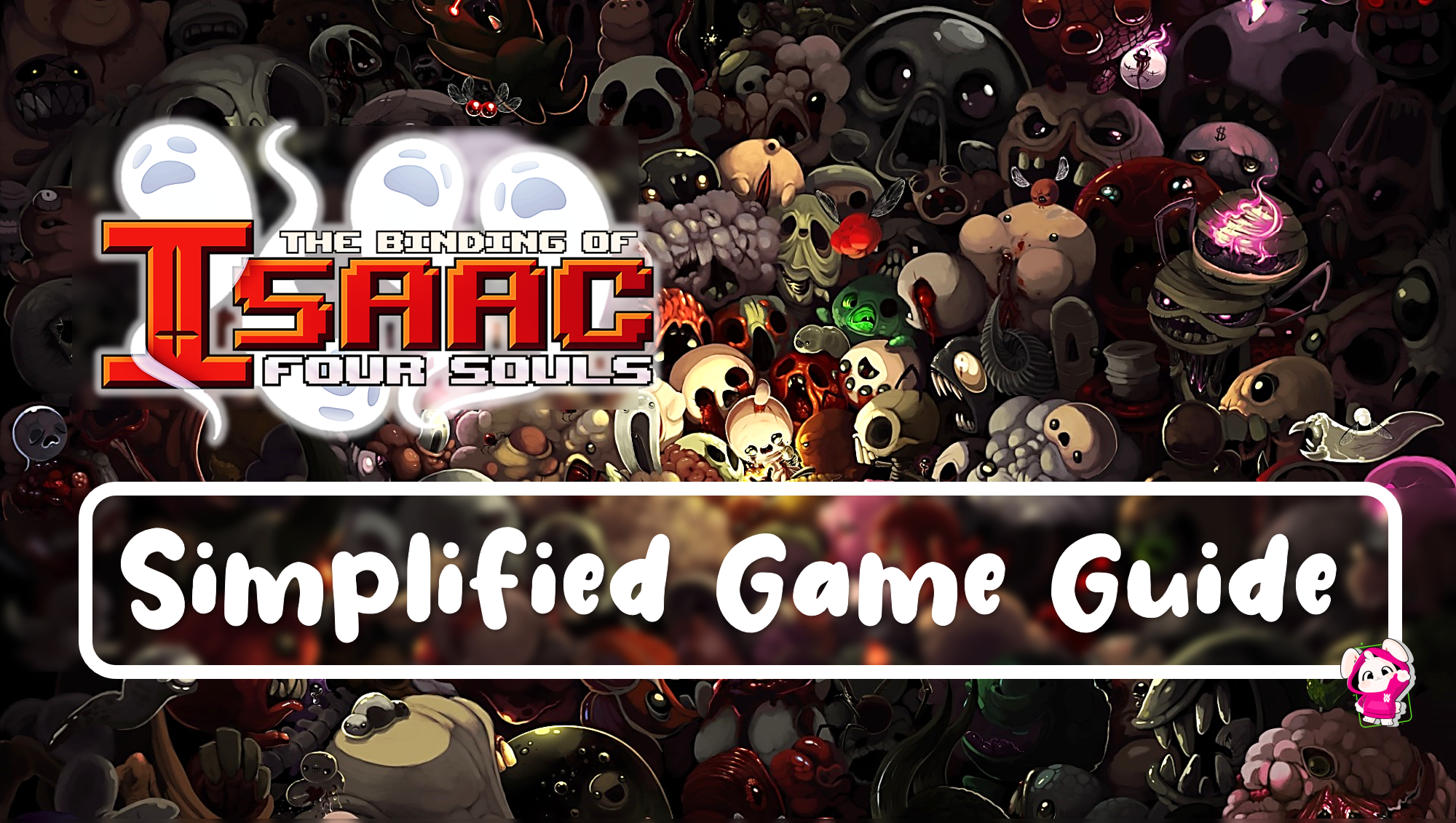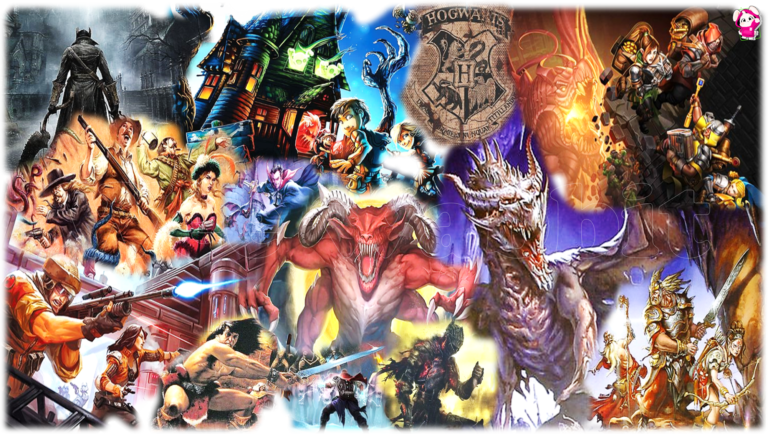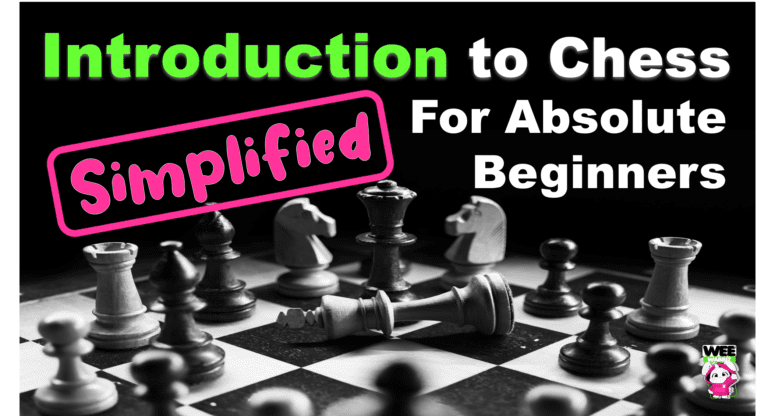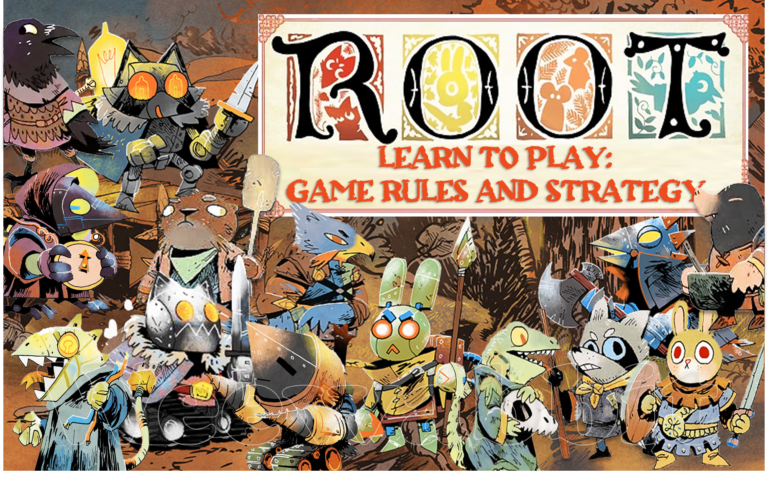“The Binding of Isaac Four Souls” is a captivating multi-player card game that brings the quirky and darkly humorous world of the popular computer game to your tabletop. Designed for 2-4 players, it masterfully combines strategy, chance, and adventure, offering a unique experience with every play. The game revolves around characters from the Isaac universe, each equipped with special abilities and items, battling monsters and collecting loot to emerge victorious. Simple to learn but rich in strategy, it’s perfect for both casual and avid gamers. Its engaging gameplay and creative design make it a standout choice for game nights and a testament to the innovative mind of creator Edmund McMillen and Maestro Media.
Game Overview

“The Binding of Isaac: Four Souls” is not just a card game; it’s an adventure into a world filled with challenges, surprises, and strategic decision-making. At its core, the game is about players taking on the roles of characters from the Isaac universe, each battling monsters, collecting powerful items and secure four souls to claim victory.
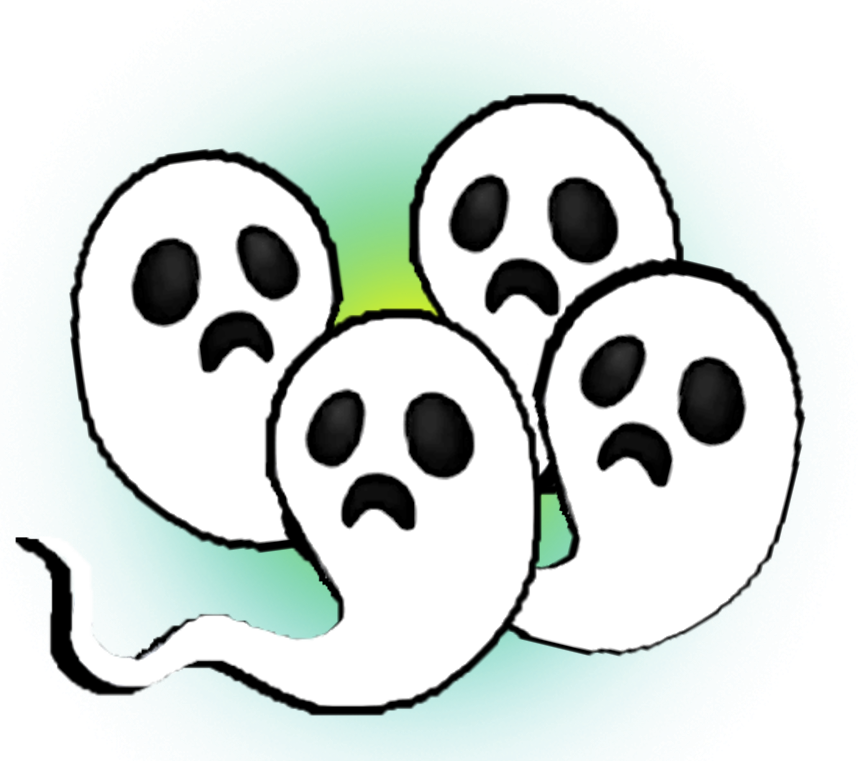
Players must navigate through strategic battles, negotiate trades, and sometimes outwit their peers to progress. With a dynamic mix of skillful planning and the element of chance dictating each turn, ‘Four Souls’ guarantees a fresh and exciting experience in every session, making it an ideal choice for those who appreciate thoughtful gameplay and interactive dynamics.”
The Binding Of Isaac Terminology
To fully grasp and enjoy Isaac world, it’s crucial to understand the specific terminology used in the game. These terms not only define the mechanics but also enrich the gameplay experience, allowing players to strategize more effectively.
Here’s a breakdown of key terms you’ll encounter in the game.
- Activate: This involves using an item’s special ability, item can be activated if it has a turning arrow symbol.
- Active Player: The player currently taking their turn. This player makes decisions and performs actions during their turn.
- Actions: These can include a range of activities, like using an item, attacking a monster, drawing from the loot deck, purchasing an item, playing a loot card, rolling dice, or responding to a passive item or monster effect.
- Ambush When an ambush card is played, it turns into a monster in an available monster slot. The player whose turn it is must attack this new monster during their turn.
- Cancel To cancel something means to remove it before it has an effect. This action is used for items or actions that are waiting to happen.
- Counters: These are markers placed on certain cards as specified by game rules or card effects. They can be represented by any small object, like a stone, dice, or coin.
- Curse A curse card is given to a player by the player whose turn it is. When the cursed player loses all their health, the curse card is discarded.
- Deactivate: This term is used when an item is turned sideways, indicating that its abilities are currently not in use.
- Destroy: When a card is destroyed, it is placed in the appropriate discard pile, removing it from active play.
- Discard: This happens when loot is used or when a monster in play is removed from the board without being killed. Discarded items go to their respective discard piles.
- Eternal: Refers to items in the game that are immune to being destroyed or discarded. These items provide continuous effects or benefits and remain in play permanently, adding a layer of strategy in how they are utilized or countered.
- Effects: refers to the specific actions or consequences that are triggered when cards are played or certain conditions are met in the game. These effects can vary widely depending on the type of card or game situation and can include things like gaining resources, affecting other players, modifying gameplay rules, or engaging in combat with monsters.
- Expand Slots This means you add more available spaces to a certain area of the game, like where monsters or items go.
- Flip Flipping a card means turning it over. Flipping a dice roll means you change the result to what you’d get if you subtracted the roll from seven.
- Gain To gain something means to take control of an item or resource that wasn’t yours before.
- Guppy: This serves as a marker for some specific abilities.
- Heal: Recover that many HP. An object cannot be heal beyond its max HP.
- Indomitable Indomitable monsters can’t be hidden or replaced. If you need to place one and there’s no room, you make extra space for it.
- Level Up/Down Adding a level counter means you level up. Removing one means you level down.
- Loot ×: If a card instructs a player to “loot ×” (for example, loot 3), it means the player draws that number of loot cards into their hand.
- Play Playing a card means taking it from your hand and putting it into action.
- Prevent Preventing damage or death means stopping it before it happens. If you prevent death, you also regain enough health to stay in the game.
- Recharge: Return a deactivated object to a charge state (Turned Upright)
- Souls: These are the points used to determine the winner of the game. Each boss monster has an associated soul, and defeating a boss earns the player that soul. Souls should be kept visible to all players.
- Reroll: to reroll a dice roll, roll that dice again. to reroll an item, destroy it and gain +1 Treasure
- Trinket When you play a trinket, it turns into a permanent item that you control.
- Triggered Effects: Abilities that are put onto the stack when a condition (or sometimes multiple conditions) are met. They begin with words like “when,” or “at,” or timing phrases such as “each time,” “every other time,” or “the 4th time”, before then detailing what is put on the stack when that condition is met.
These terms are fundamental to understanding and enjoying providing a framework for gameplay and strategy.
Card Decks And Their Purposes
Players will come across various types of cards, each serving a unique purpose in the game. Let’s take a look at each one, how they work and their uses.
Character Cards

These are the heart of your game persona. Each character card represents a different character from the Isaac universe, complete with special abilities. Think of these cards as your identity in the game world.
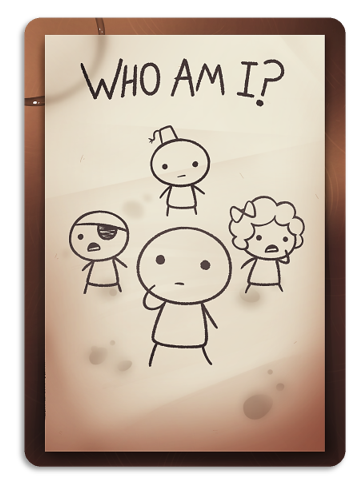
Who are the different Playable Characters in The Binding Of Isaac?



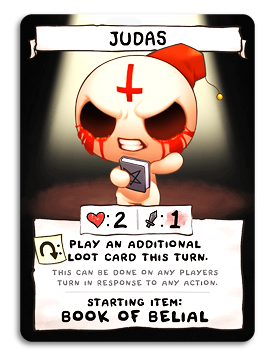


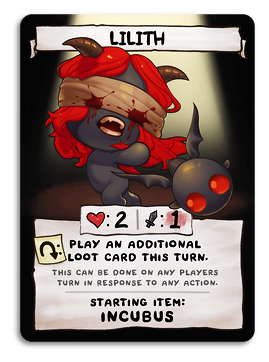




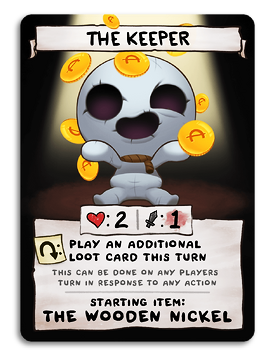



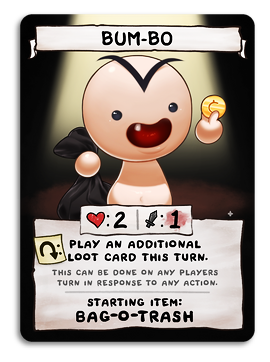



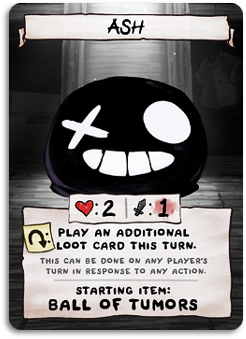



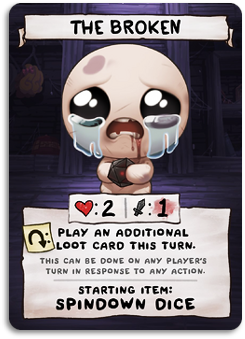

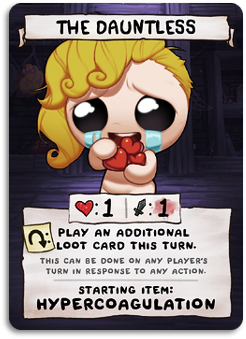
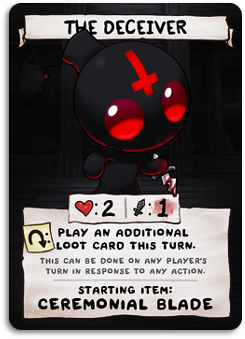



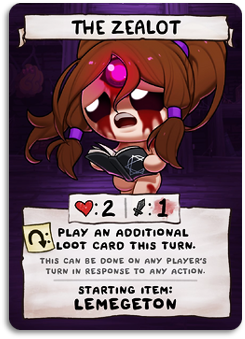

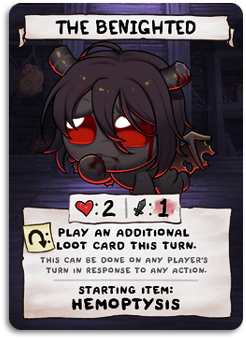
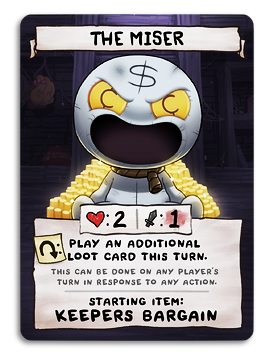


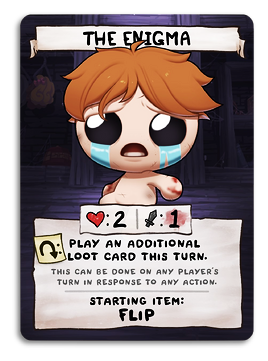

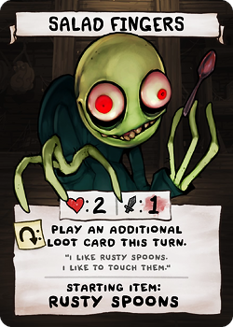

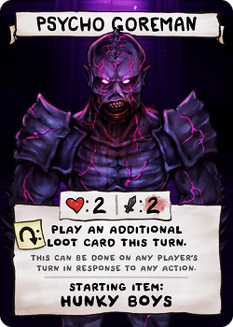


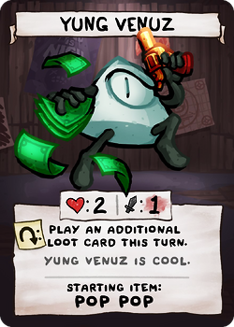
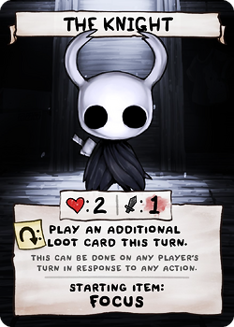

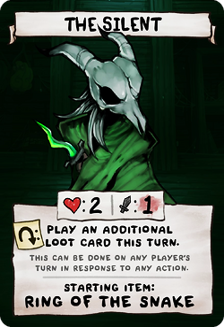
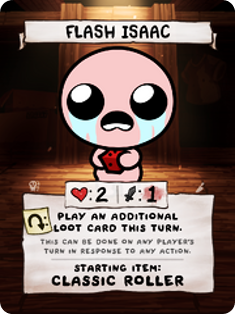
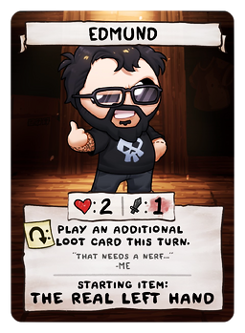
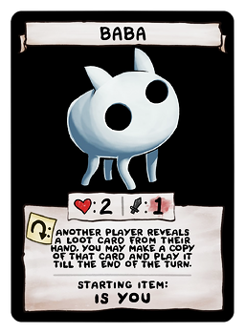


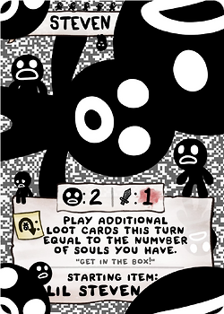



Starting Item
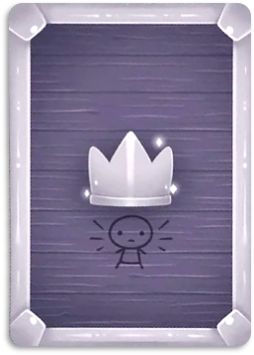
These cards are paired with the character the player chooses or is assigned at the beginning of the game. Each Starting Item Card typically represents an ability or advantage that is unique to that character, reflecting their special skills or traits.
Starting Items for each Characters:
Here are the Characters Cards in “The Binding Of Isaac Four Souls” side by side with their Starting Item Cards.






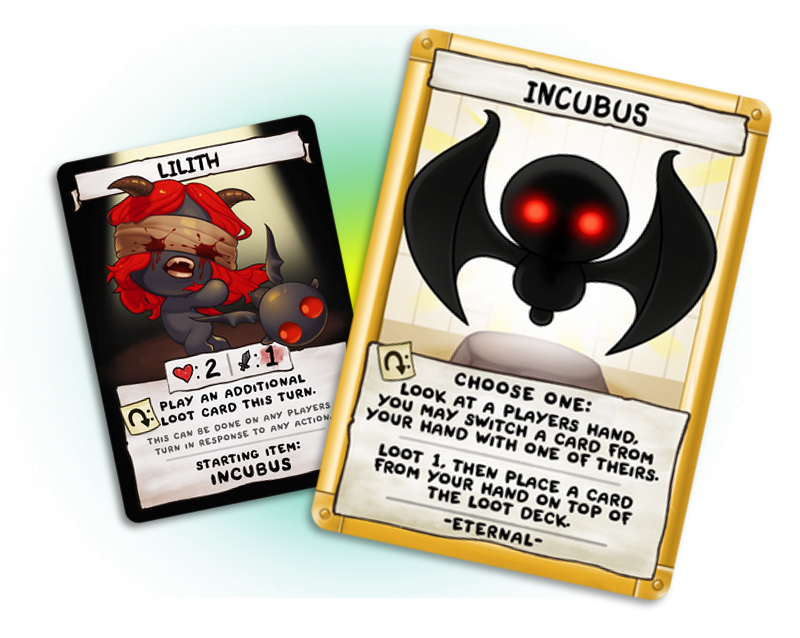
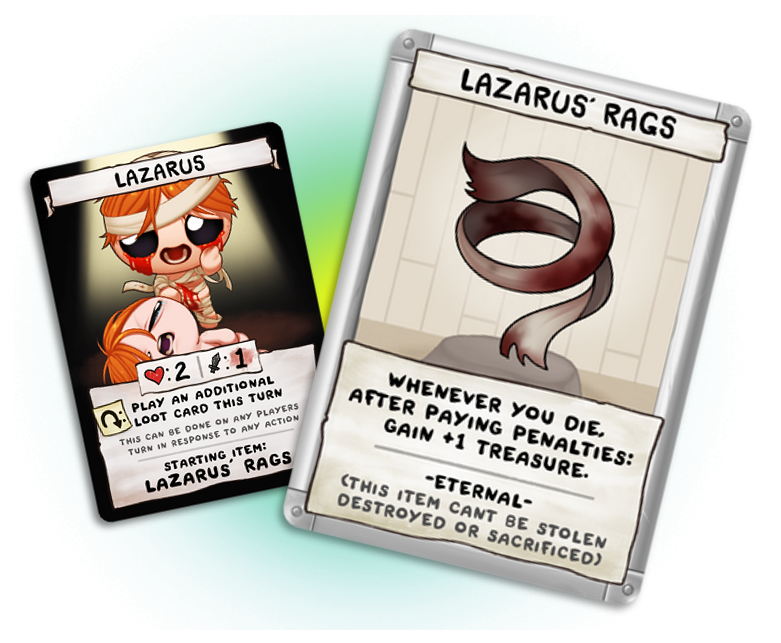


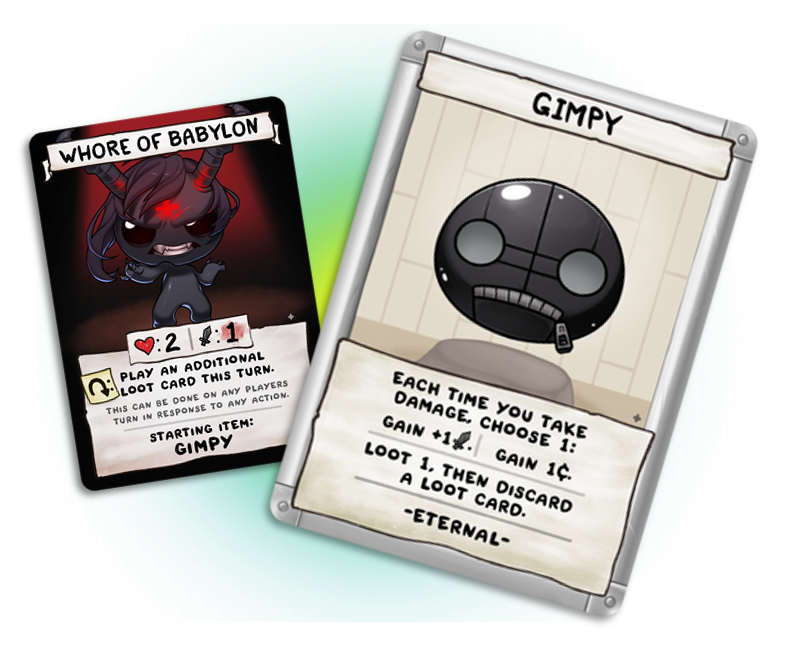







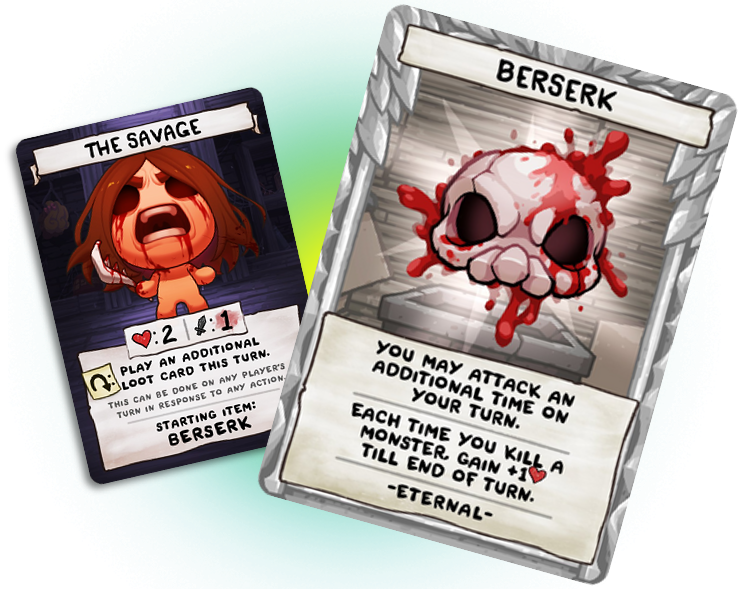


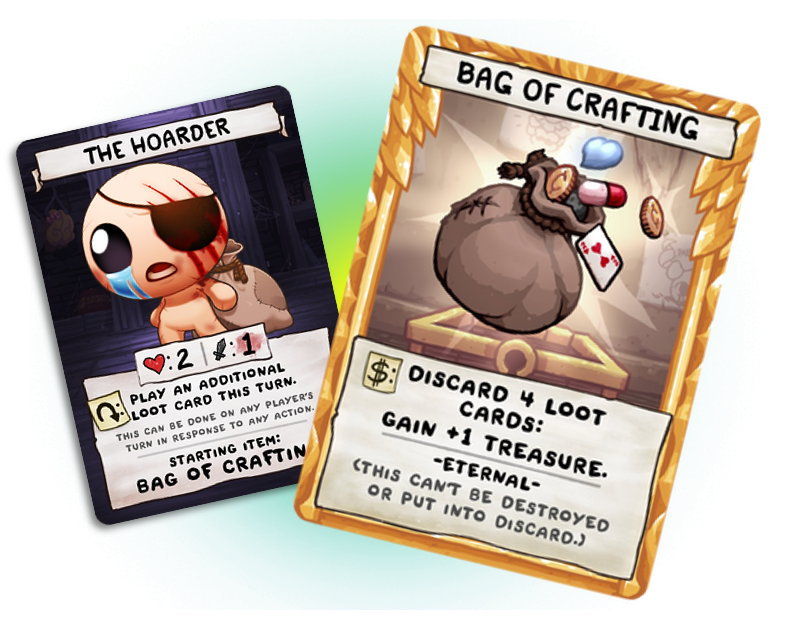



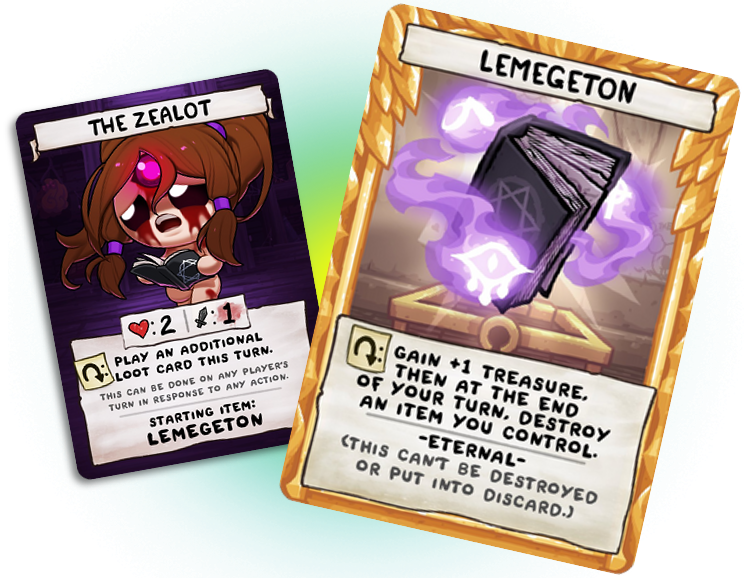


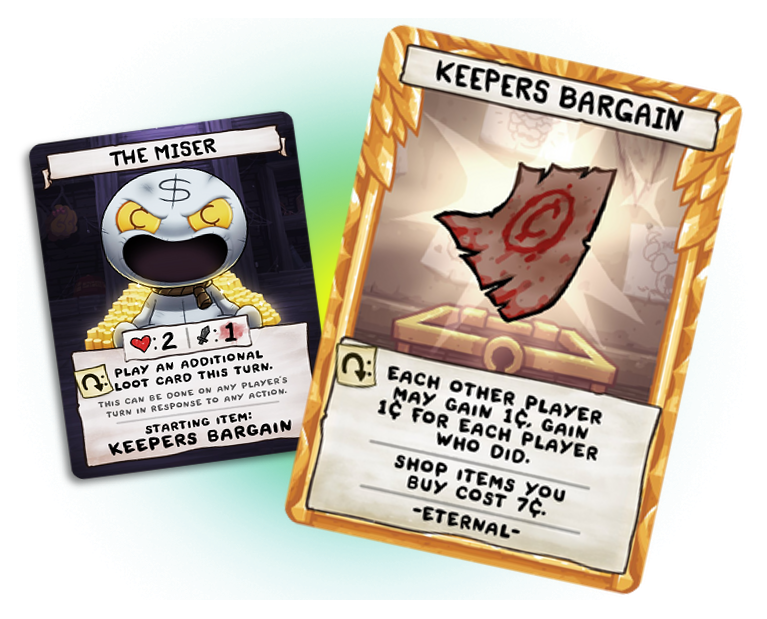

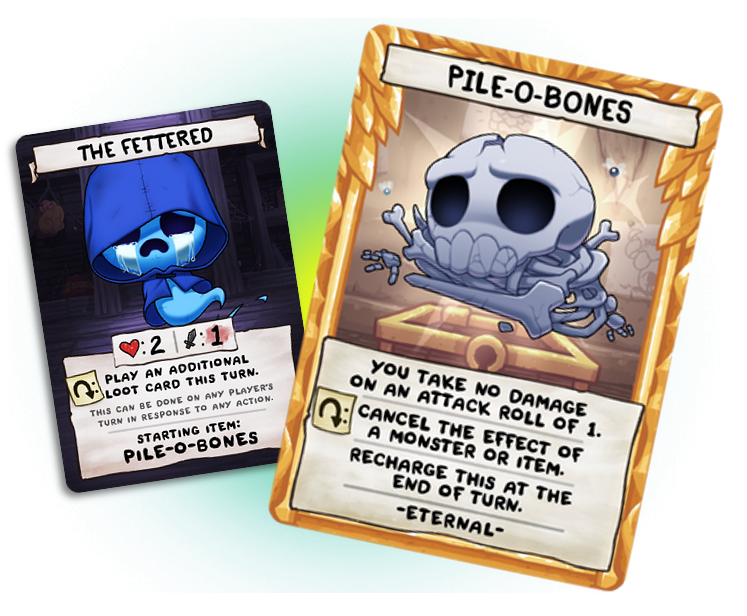

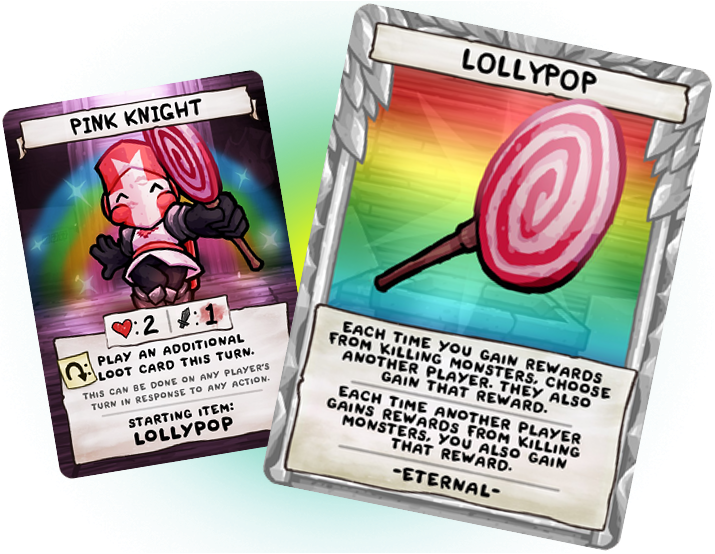



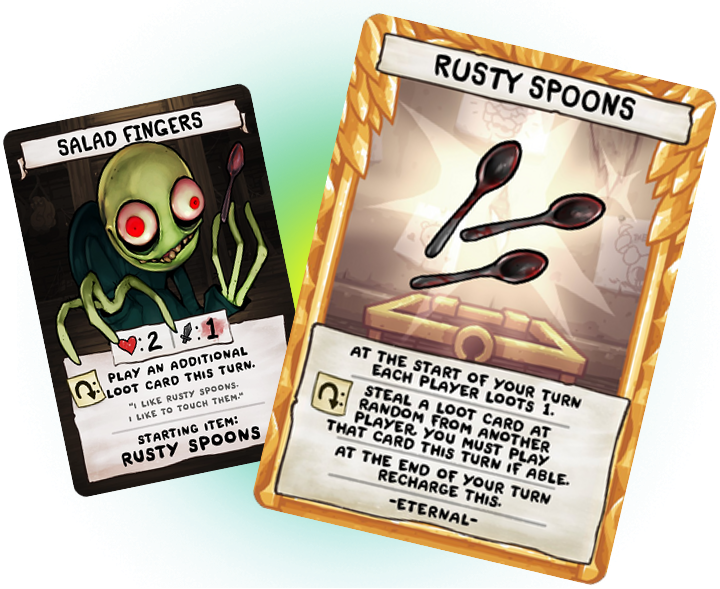

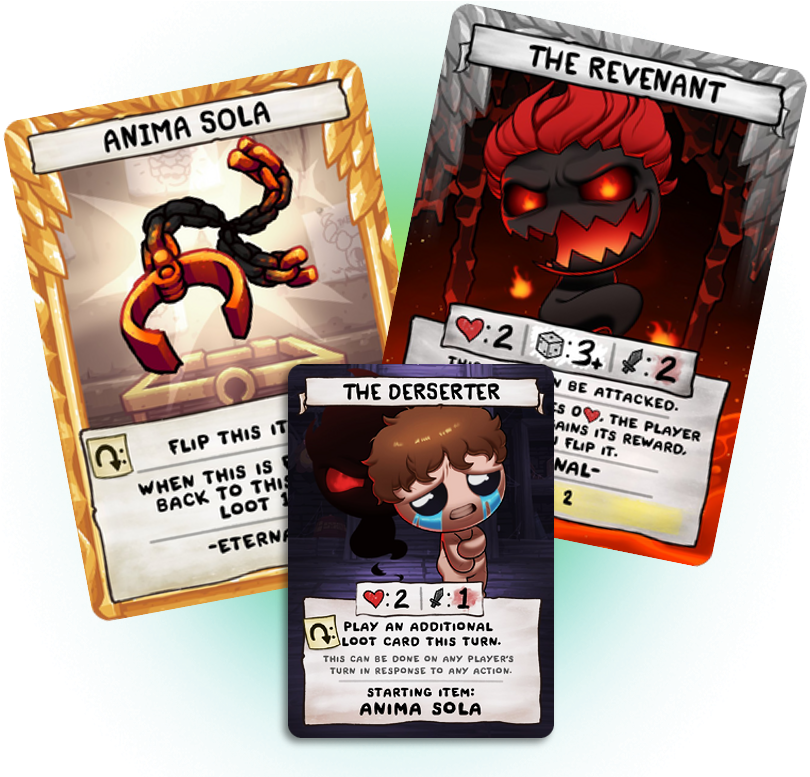




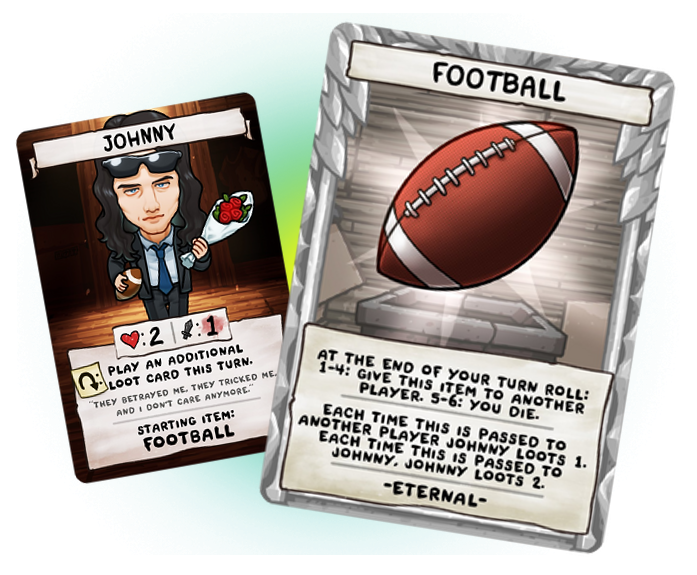


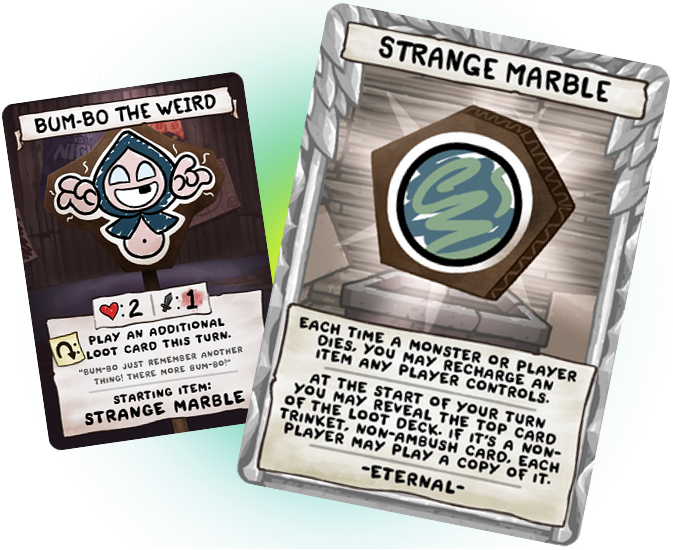

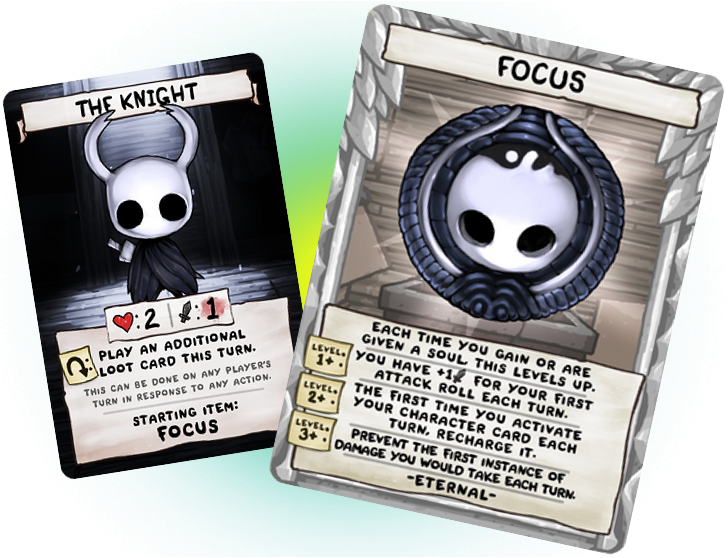




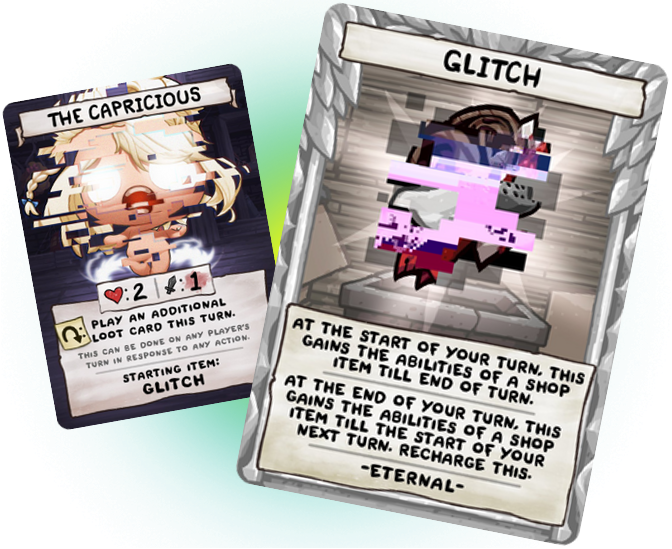
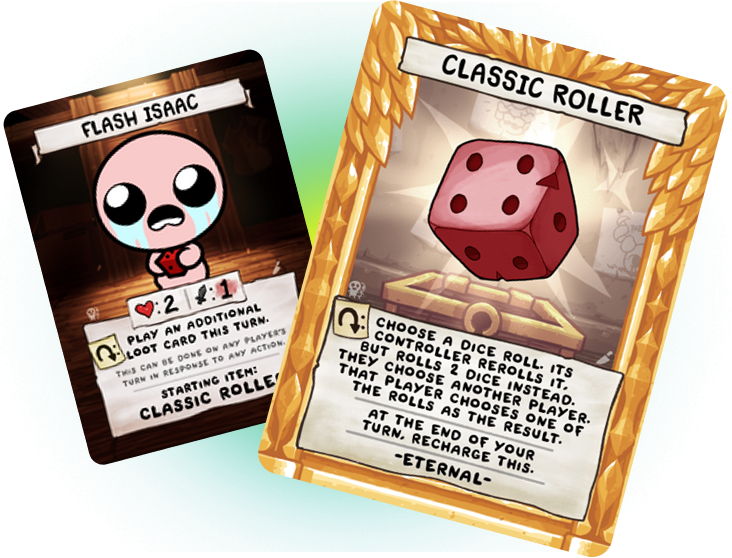
After picking the paired starting item for everyone’s characters, the rest of this deck is set aside. (This deck of card should not be confused and mix with the Treasure deck, they are not the same.)
Loot Cards


These are your tools for strategic advantage. Loot cards are unique, they are the only cards drawn and kept in hand by players.
Utilizing these cards can rapidly alter the game’s progression.

What are the different kinds of LOOT Cards?

Basic Loot Cards
Think of these like your everyday items in a game. They are things like coins (for buying stuff), bombs (for blowing things up), hearts (to keep you going), and pills (which have different effects). You use these cards to get resources or help you in fights. They’re pretty straightforward and easy to use.

Tarot Cards
These are special cards that can really change how the game is going. They’re more powerful than Basic Loot and can do some really cool things. For example, a Tarot card might let you take an extra turn or stop an enemy in their tracks.

Trinkets
These are rare and special. When you play a Trinket card, it’s like getting a permanent boost or helper. You put these cards on the table, and they keep helping you until they’re destroyed. They’re kind of like having a special tool or gadget that keeps giving you an advantage.
Knowing when to use these Loot cards can really help you win. It’s about making smart choices and using what you have at the right time.
Treasure Cards


The game changers. Treasure cards are valuable items that players acquire in the game. These cards are immediately placed in front of the player, visible to all. They possess potent effects that significantly influence gameplay, often interacting with other players and monsters, thereby shaping the game’s dynamics.
What are the 2 kinds of TREASURE Cards?
1. Active Items

Active items are that with a gold border and describe the effects you can play.
Active cards can be used either by activating them during your turn or by paying a cost .

Activated Effects
To use them, you turn the card sideways to show it’s been activated. However, before you can activate it again, you must ‘recharge’ it, which usually happens at the start of your turn.
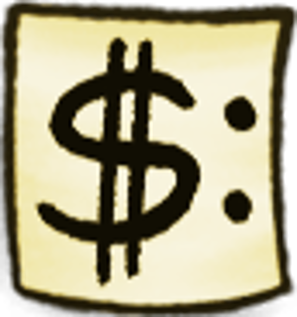
Paid Effects
Marked with a dollar sign symbol, these effects require you to pay a specified cost to use them. Unlike activated effects, paid effects do not require the card to be recharged and can be used as many times as you can pay the cost during your turn.
2. Passive Items

They are distinguishable by their silver borders. They give players either special abilities or described trigger effects.(effects that are automatically played under certain conditions) Passive Items don’t require activation to use their effects. They continuously provide their effects, making them a consistent advantage in the game.
Treasure cards add depth and complexity to the game, offering players various strategies and ways to interact with other players and monsters.
Monster Cards

The Monster deck is a central component of the game, offering a variety of challenges and rewards.

What’s are the different kinds of MONSTER Cards?

Basic Monsters
These are the more common enemies you’ll face. Basic Monsters are generally easier to defeat compared to other types. Defeating these monsters often yields loot and coins, and on rare occasions, you might even get a treasure. They are the standard foes you’ll encounter and are essential for progressing in the game.

Bosses
Boss Monsters represent a significant step up in difficulty. They are harder to defeat, but the rewards for doing so are much greater. One of the key rewards for defeating a Boss is a soul. Souls are critical for winning the game, as collecting them is one of the primary objectives. When you defeat a Boss, you keep that Boss card as a way to track the souls you’ve earned.
Non-Monster Cards

Bonus Cards
These are less common and offer a mix of risks and rewards. Bonus cards can provide valuable resources or benefits, but they also come with the potential for negative consequences, including the possibility of your character being killed.
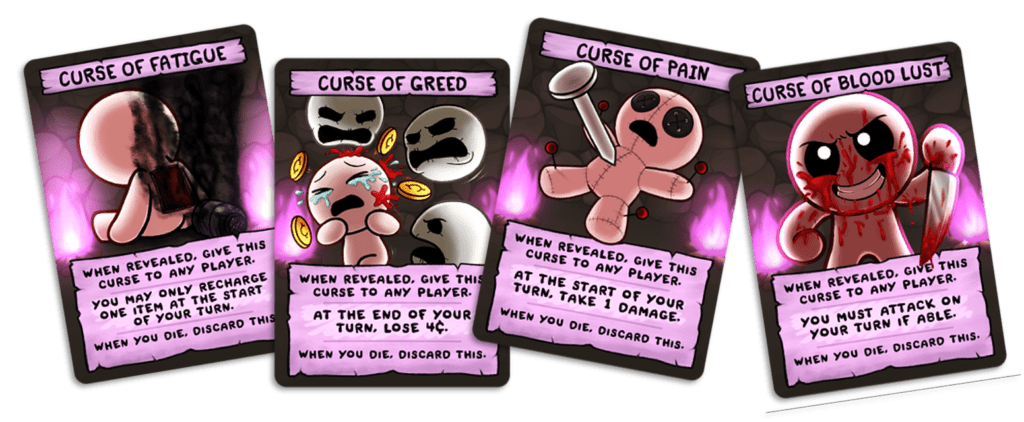
Curses
Curse cards are rare and have a unique impact on gameplay. When a Curse card is drawn, the player who revealed it can choose which player (including themselves) receives the curse. These curses are placed next to the player’s Character card and generally have ongoing negative effects. The curse is only lifted when the cursed player dies, at which point the Curse card is discarded.
Each type of card in the Monster deck adds a unique element to the game, creating a dynamic and unpredictable experience. Players must strategize not only how to defeat monsters but also how to deal with curses and leverage bonus cards effectively.
The Bonus Souls
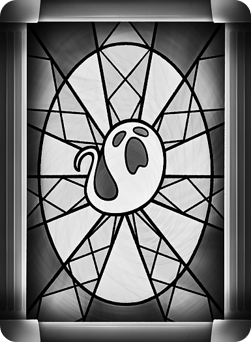

Once players are comfortable with the basic game mechanics, they can introduce an exciting element called Bonus Souls. They are special cards that can greatly influence the outcome of the game. Players can earn these cards by meeting specific conditions during gameplay.
What are the different BONUS SOUL Cards?
Bonus Soul Cards include the Soul of Guppy, the Soul of Greed, the Soul of Gluttony, the Soul of Pride, the Soul of Envy, the Soul of Lust, the Soul of Sloth, and the Soul of Wrath.
When you begin a game and include bonus souls, mix them up and randomly select 3. These chosen three become the active bonus souls for that game.
Placement and Visibility
These Bonus Souls aren’t part of any deck. Instead, they are placed face up on the table, next to the game decks. This way, all players can easily see them, adding another layer of strategy to the game.
How do you Earn The Bonus Souls?
To earn each of the “Soul” Cards” players must fulfill specific conditions during gameplay.
Soul of Greed

This soul is claimed by the first player who accumulates 25¢ or more. It’s a race to gather coins, and reaching this monetary goal rewards the player with this soul.
Soul of Gluttony
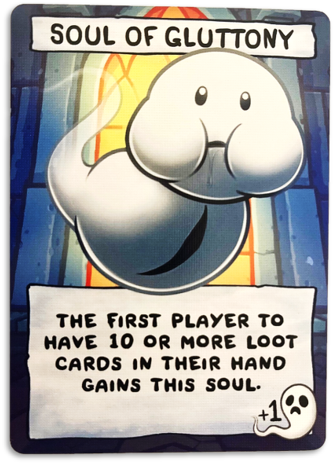
This soul is awarded to the first player who has 10 or more Loot cards in their hand. It requires players to accumulate a substantial number of Loot cards, a feat that reflects the soul’s theme.
Soul of Guppy

To gain the Soul of Guppy, a player needs to have 2 or more Guppy Items in their possession.
What are the Guppy Items To Collect to gain the Soul Of Guppy?
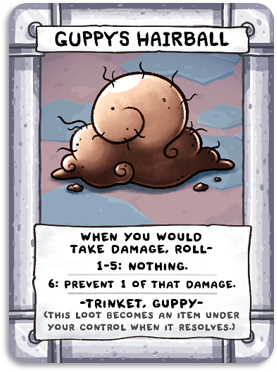


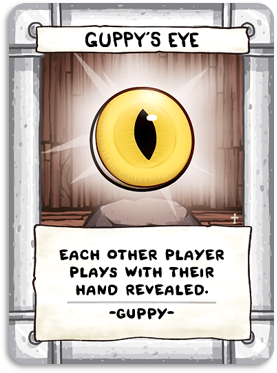
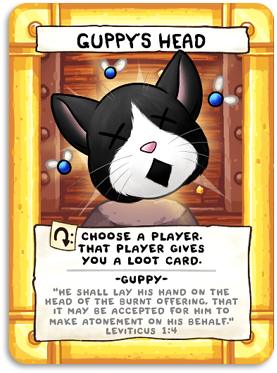

Soul of Envy

When a player gets their third soul, the active player then grants the Soul of Envy to the player with the fewest souls, adding a layer of strategic choice and potential balancing to the game dynamics.
Soul of Lust
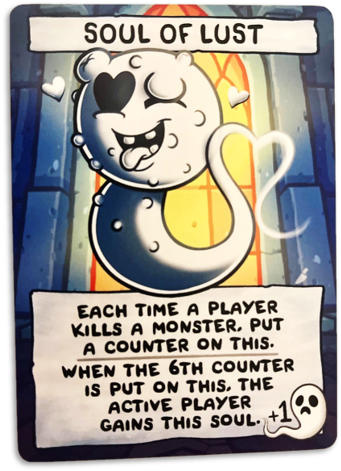
This card is about combat achievements. Each monster defeated by any player adds a counter to this card, and the player in action when the sixth counter is placed gains the Soul of Lust. It’s a reward for aggressive gameplay and successful monster confrontations.
Soul of Pride

Consider this card as a testament to resource acquisition. Similar to a progress tracker, each time a player acquires a treasure, a counter is placed on this card. The active player at the time the sixth counter is placed earns the Soul of Pride, marking a milestone in treasure collection.
Soul of Sloth

This card rewards the underdog – the player with the fewest items. When someone collects their fourth item, it triggers the opportunity for the current player to award the Soul of Sloth to the player with the least items, making strategic generosity part of the game.
Soul of Wrath

This card is tied to the in-game mechanic of player defeat. It’s claimed by the player who is active when a sixth player is knocked out of the game. Each player’s defeat adds a counter to the card, and the active player at the time of the sixth counter claims it.
One-Time Gain
Each of these souls can only be gained once per game, which means once a player has claimed a particular soul, it’s off the table for the rest of that game. This rule adds a sense of urgency and competition to be the first to meet the conditions for each soul.
Remember, each soul can only be earned once per game, which adds a layer of strategy as players race to meet these conditions before their opponents. It’s a great way to add depth and challenge to the game, encouraging players to adapt their strategies to these new objectives.
Room Cards

Room cards adds another dimension to the game, providing various effects when they come into play. These cards are not part of the standard game setup but can be included for added complexity and variation.

Room Cards








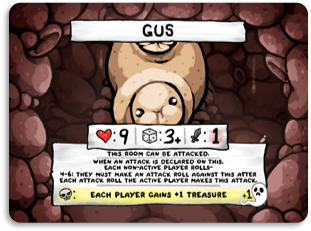
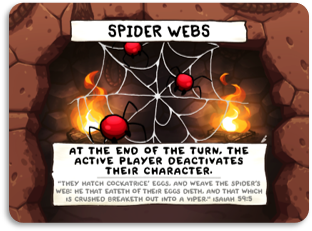
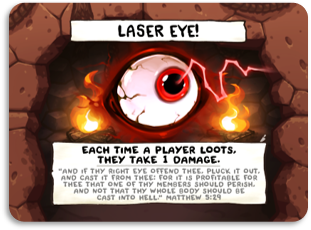

















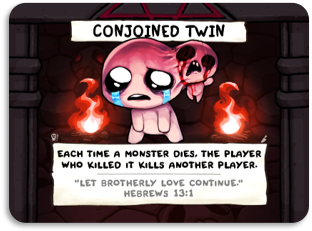

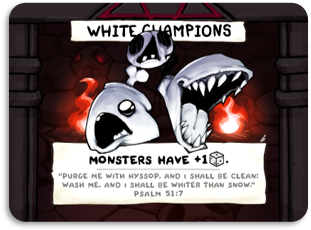
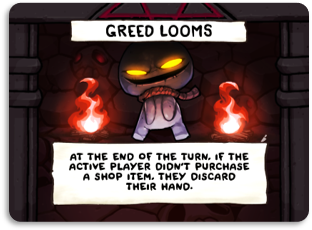








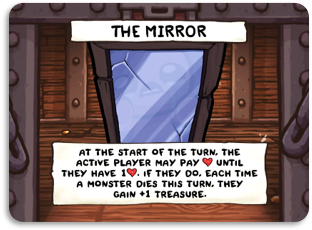




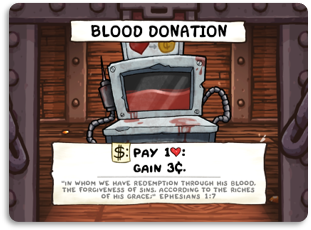
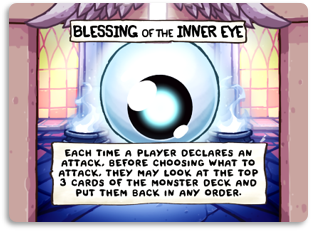






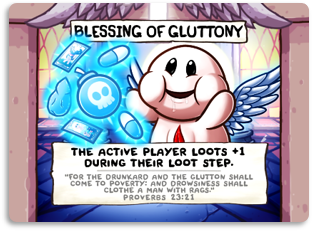


Each card type brings its own flavor to the game, making every round a new adventure full of strategic decisions and unexpected turns.
Winning the Game

The goal is to be the first to gather 4 souls to win the game.
How do you gain Souls?
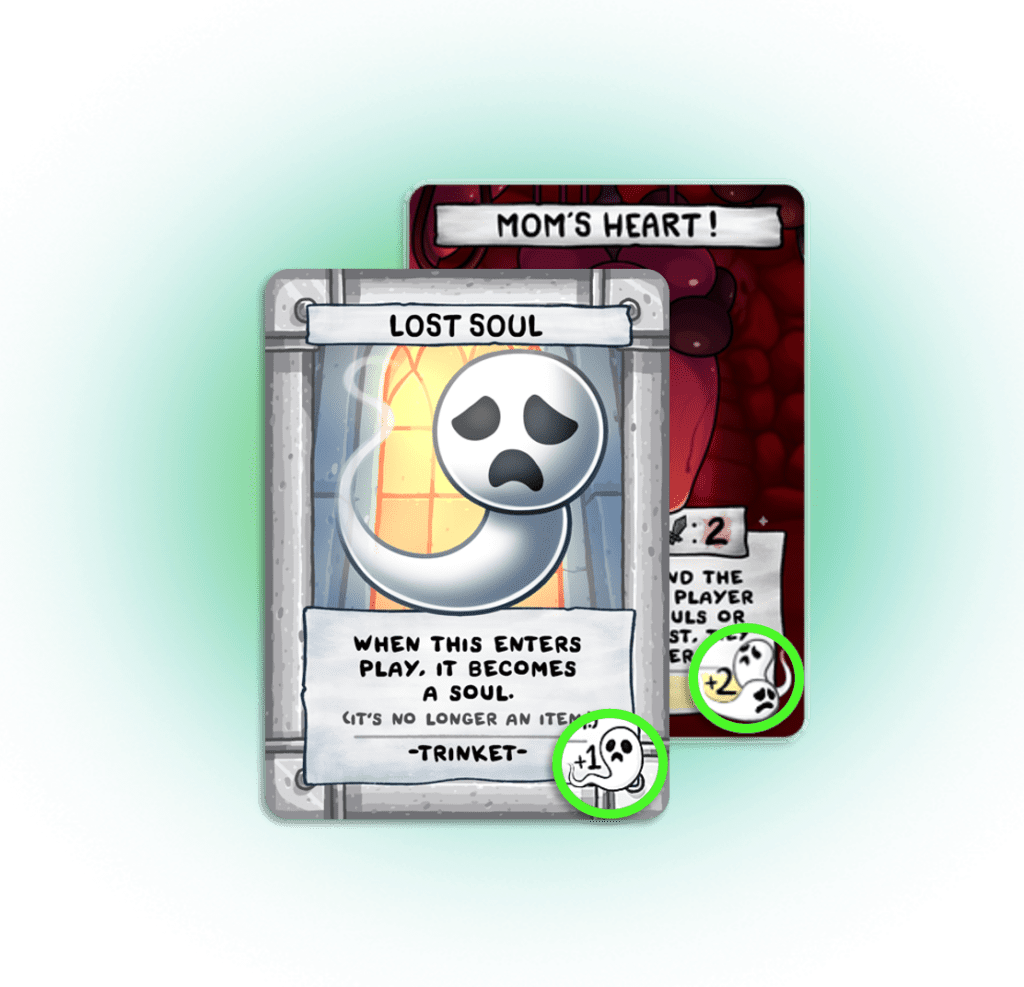
Any card with the soul symbol can turn into a soul
card. The soul symbol says how many souls that
soul card is worth.
Gathering four souls is the key to winning. There are multiple ways to gain them. Let’s explore ways how you can snag these souls.
How do you gain Souls?
Accomplishing The Bonus Souls Conditions

Each Bonus Soul card is a mini-challenge waiting to be conquered. Whether it’s amassing a specific number of items or being the fastest to reach a milestone, completing these conditions rewards you with a soul.
Defeating Boss Monsters
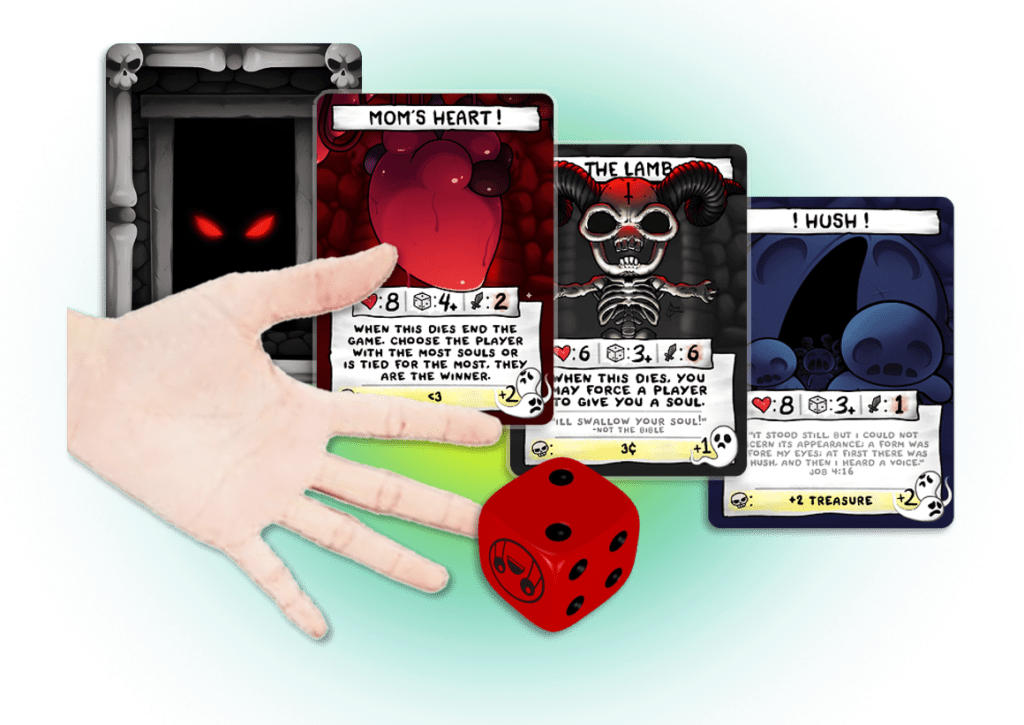
Facing off against Boss Monsters is a daring endeavor that can pay off handsomely. Overcoming these formidable foes rewards you with a soul for each boss you defeat, some even have 2 souls to gain.
Non-Monster Card Effect

Certain non-monster cards also offer souls as a bounty for completing specific tasks. Engage with cards like the Holy Chest, and if luck is on your side with a roll of a 6, a soul becomes yours for the taking.
From The Treasure Cards

Treasure deck cards are more than just items and effects; some hold the key to earning souls. Keep an eye out for these treasures.
Attacking a Room

If you’re playing with room cards included, be on the lookout for rooms like Gus. That’s another soul.
By Stealing
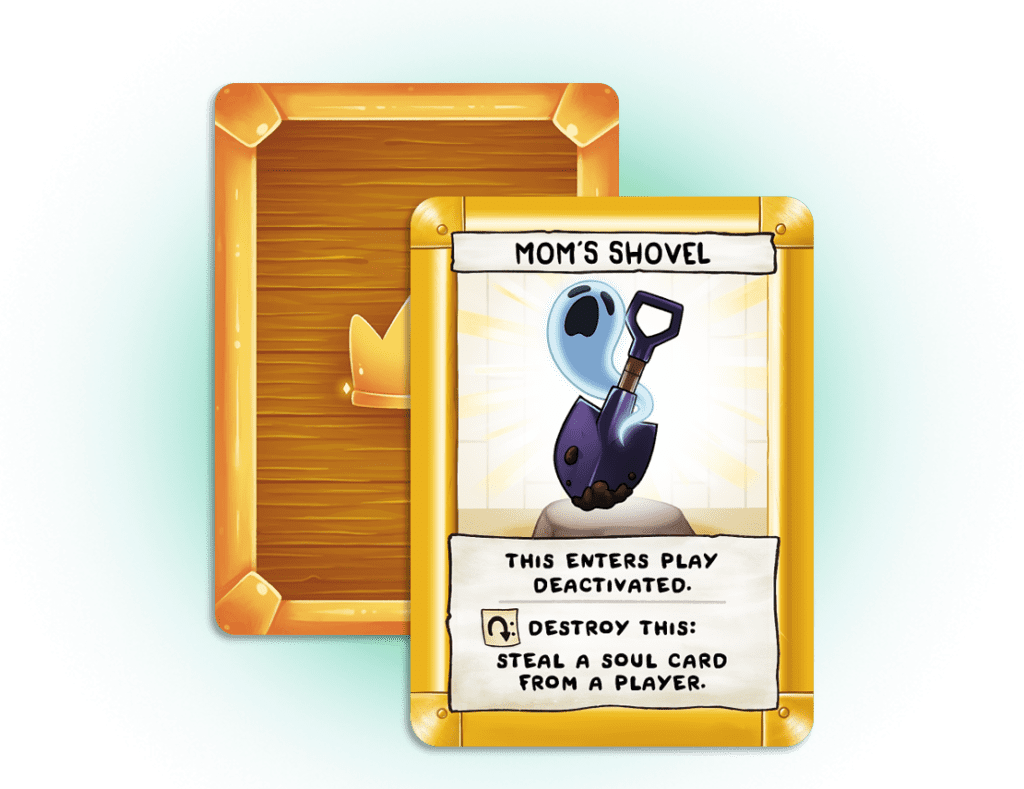
And yes, you can even pilfer souls from your opponents! Certain cards allow for some good old-fashioned thievery. Use cards like Mom’s Shovel to dig one up from an unsuspecting player.
Now that we’ve familiarize ourselves with the different card components and the main objective, “to be the first to gather 4 souls”, let’s set the stage ready.
Game Setup
1. Choose a Character

Each player chooses a character card. Take a moment to get acquainted with your character’s special ability, as it will be a key asset in your quest for victory.
2. Prepare the Decks
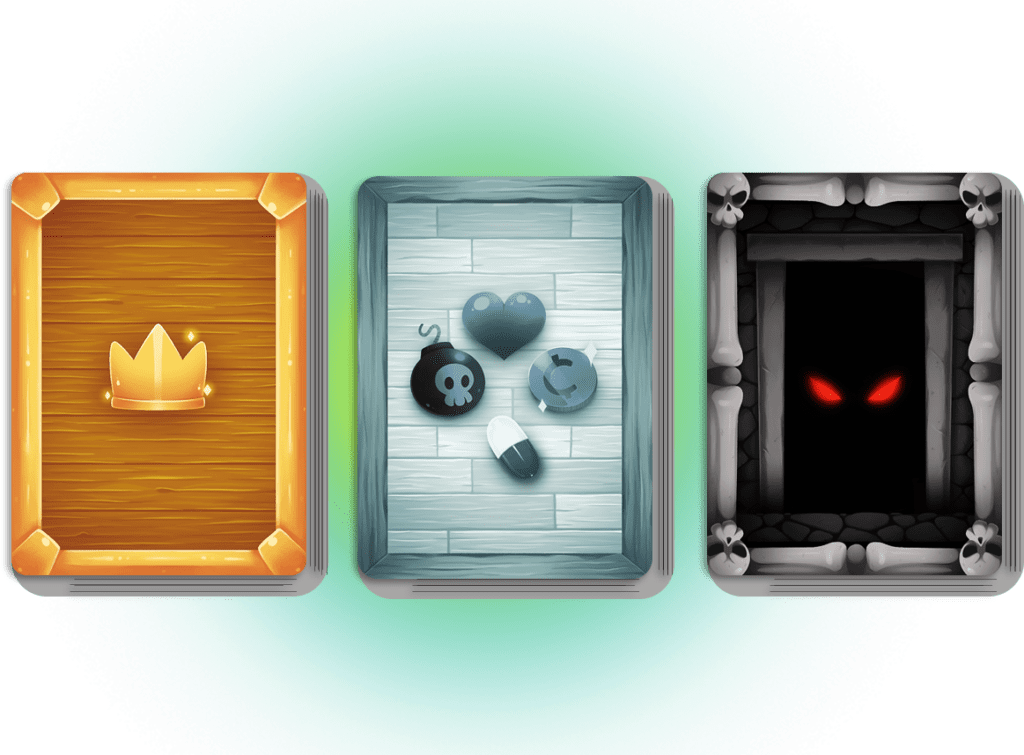
Shuffle the Treasured deck, Loot deck, and Monster deck.
To set up the TREASURE deck you would…
- Treasure Deck: Shuffle the treasure deck thoroughly.
- Create the Store: Draw the top two cards from the treasure deck and place them face up in the center of the play area where all players can see them.
- Store Accessibility: These face-up cards form the initial store that players can buy items from during their turns.
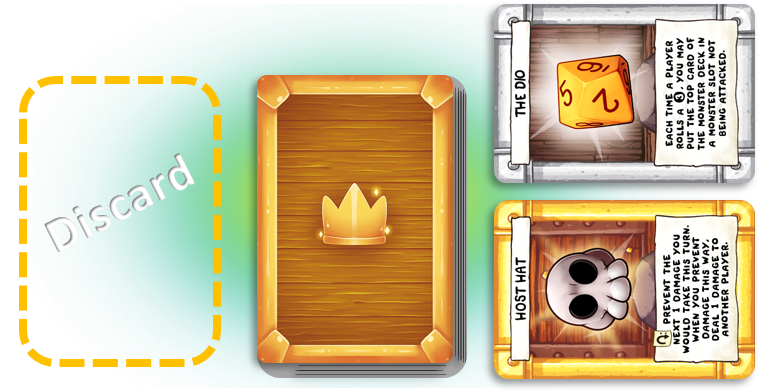
The store is a dynamic part of the game where players can purchase items to aid in their quest to gather four souls. As items are bought, new ones are drawn from the treasure deck to replace them, keeping the store’s options fresh.
To set up the LOOT deck you would…
- Shuffle the Loot Deck: Mix the loot cards thoroughly to ensure a random distribution.
- Deal Starting Hands: Give each player 3 loot cards from the top of the deck to start their hand.
- Place the Deck: Put the remaining loot deck within reach of all players, usually in the center of the play area.

This creates a draw pile that players will use during the game to draw new loot cards, typically at the beginning of their turn or due to specific game effects.
To set up the MONSTER deck you would…
- Shuffle the Monster Deck: Mix up the monster cards to ensure unpredictability in gameplay.
- Place the Deck: Put the shuffled monster deck face down in a designated area that’s accessible to all players.
- Reveal Monsters: Draw the top few cards (typically two) from the monster deck and place them face up next to the deck. These are the initial monsters that players will encounter and have the option to attack on their turns.
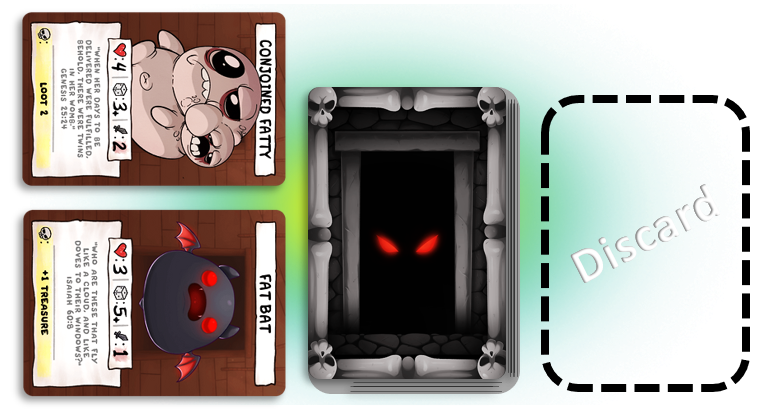
This setup creates the monster line-up that players will engage with during the game to earn rewards and souls. As monsters are defeated, new ones are revealed from the deck to take their place.
3. Add Optional Cards

If you decide to include the Room deck, shuffle it as well and put out 100 cents (place near the room deck)

If you decide to play with Bonus Souls, pick 3 random Soul cards and place on the table face up.
Place card decks in the middle of the table.

4. Distribute Starting Items

Each player gets a Character card and gets the corresponding Starting items.

Each players are given 3 loot cards and 3 pennies to start with.

Ensure each player has a way to track their health and coins, whether through tokens, stones, or any form of counters.
Your complete table set-up should be like the image below.

5. Choose The First Player
“Time to Choose who will be the first in turn.”
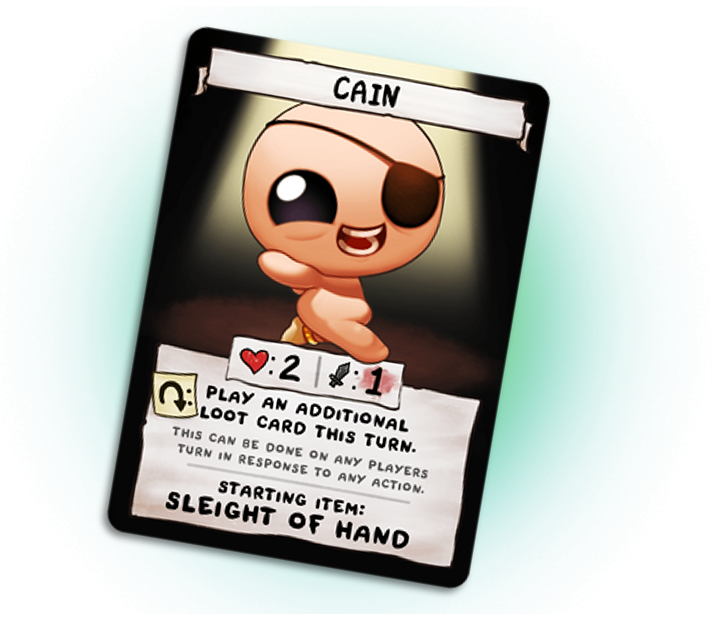
Normally “Cain” always go first turn.
Or each players rolls the dice and who ever gets a higher score is the first in turn.
With all these steps completed, you’re ready to Play.
Turn Structure
A Turn is divided into 3 parts called Phases. These are the Starting Phase, the Action Phase, and the End Phase. They are an essential processes to understand and remember since you will be doing them repeatedly throughout the game.
Start Phase
At the beginning of every Turn(Start Phase) do as follow.

Active player draws 1 loot card from the loot deck to add to their hand.
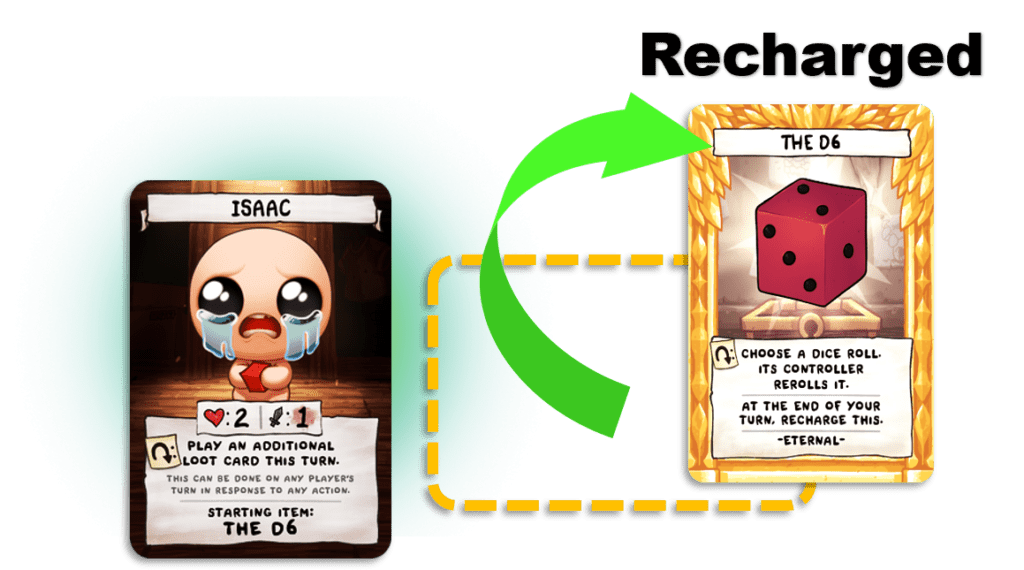
NOTE: Players ‘Recharge‘ any items they used in the previous turn by turning them upright.
Action Phase
At Action Phase, Active player may do the following below:
1. Play Loot Cards

Player gets to play Loot Cards until the end of his/her turn .
How do you “Play Loot Cards?”

To play Loot Cards, follow these steps:
- Choose a Card: Look at the loot cards in your hand and decide which one to play.
- Play the Card: Announce your chosen card and place it face up on the table.
- Resolve the Effect: Carry out the action or effect described on the card.
- Discard the Card: After the effect is resolved, put the card in the discard pile.

2. Purchase Items

Buy items from the store with coins to gain abilities.
How do you Purchase Items?
You can either purchase any shop item(face-up cards) or the top of the deck for 10 cents.

1. Choose an Item: During your turn, look at the face-up items in the store.

2. Pay for the Item: If you have enough coins, pay the cost listed to purchase the item of your choice.

3. Add the Item to Your Play Area: Place the purchased item in front of you, showing it’s now part of your collection

4. Replace the Purchased Item: Draw the top card from the treasure deck to refill the store.
This process allows you to acquire new items that can enhance your abilities and help you progress in the game.
3. Attack Monster

Declare an attack before choosing which to attack. You can’t attack a boss if there’s an are active basic monsters, the basic monster are the first to be dealt with.
You can either attack a monster at play(face-up monster cards) or the top of the monster deck.
How do you Attack a Monster?
Here’s a monster breakdown to give you a better idea.

Here are the steps on attacking a monster.

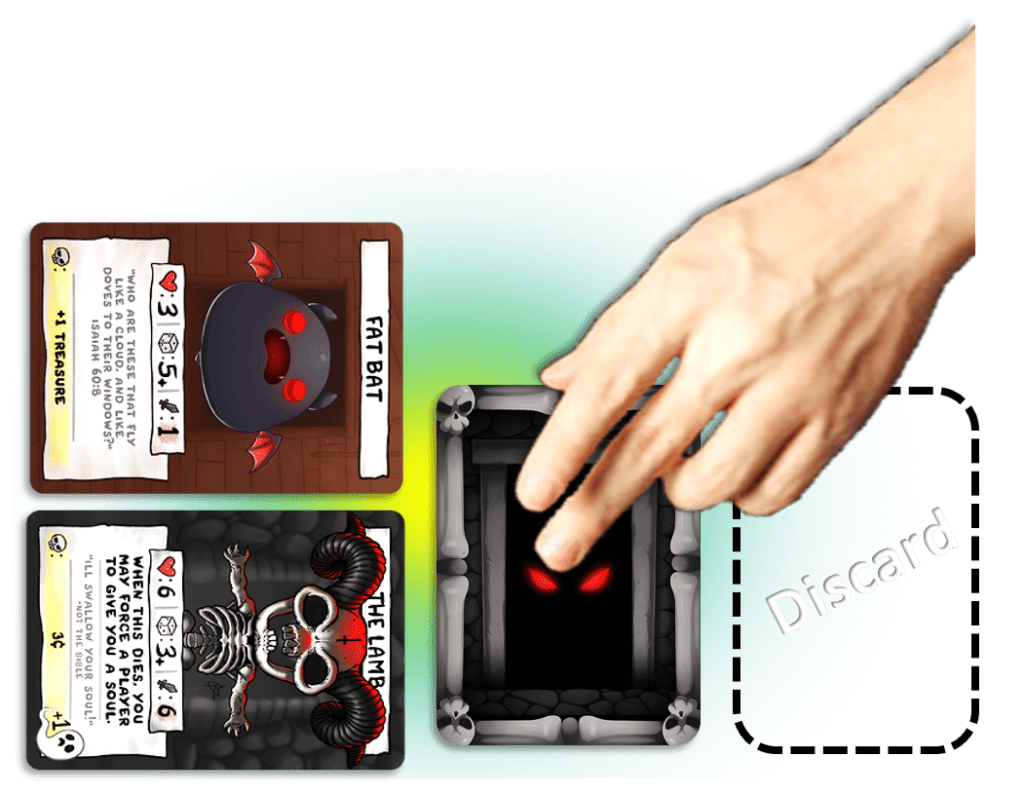
1. Choose a Monster: Select a monster from the active field(face up cards) or reveal the top card from the monster deck.

2. Roll the Dice: Roll a die to attack the monster. Compare the roll to the monster’s attack value.

3. Hit or Miss: If your roll equals or exceeds the monster’s value, it’s a hit; otherwise, it’s a miss, and the monster hits back.
4. Apply Damage: Deal damage to the monster if you hit, or take damage if you miss.
5. Continue or End: Keep rolling until the monster is defeated or your character dies. If the monster dies, collect any rewards. If you got defeated, apply DEATH PENALTY. Your turn ends. (See also Dice Rolling)
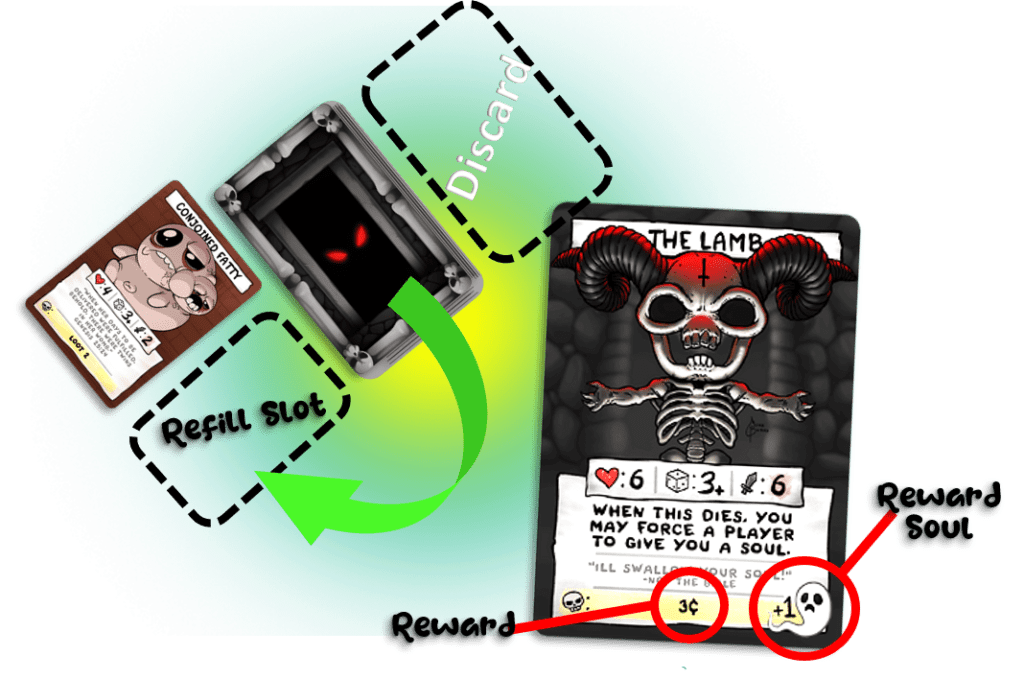
If a monster dies, active player gains it’s rewards. If it has a soul value, they gain that too. Otherwise, moved to discard pile and refill its slot.

Usually, you attack monsters in the game. But sometimes, items or rooms might have special abilities that let you attack them too. These will have their own health and stats listed. When they’re in play, you can choose to attack them just like you would a monster. The same rules for starting an attack apply, and once you start, it goes on just like attacking a monster would.
End Phase
Every “End Phase”, do as follow.

1.All players and monsters heals to full health (HP Reset).

2. Active player should discard down to 10 cards. (Maximum number of cards by default)

3. If playing with Room Deck, the active player may put a room into “discard”
4. Active player turns end, next player takes turn.
Gameplay Dynamics
Although playing “The Binding Of Isaac Four Soul” is straightforward as taking turns, there are different sets of rules on certain action, and process that we need to follow and understand. Let’s go through them, shall we?
Priority
Priority is “When to play?”, Priority determines which player can act at any given time. The player with Priority may do any of the following:
( Only the ACTIVE PLAYER on the Action Phase )

- Play a Loot card.
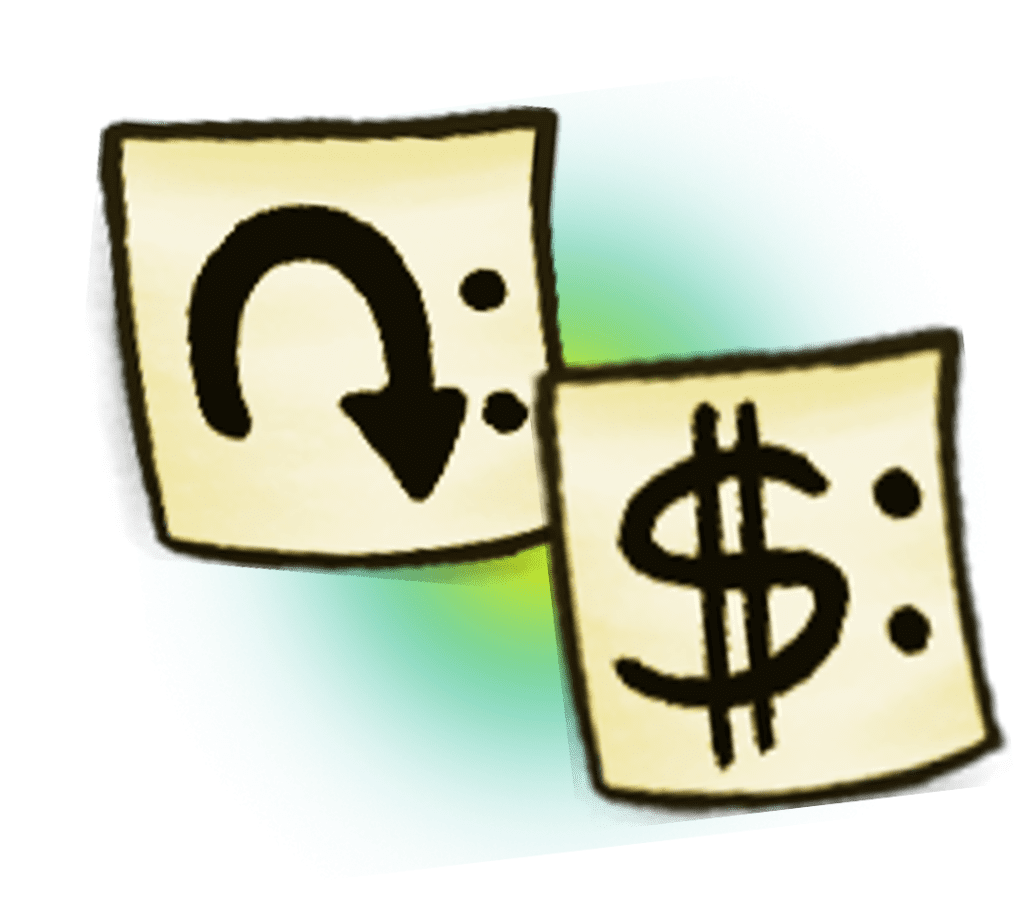
- Activate an ability.
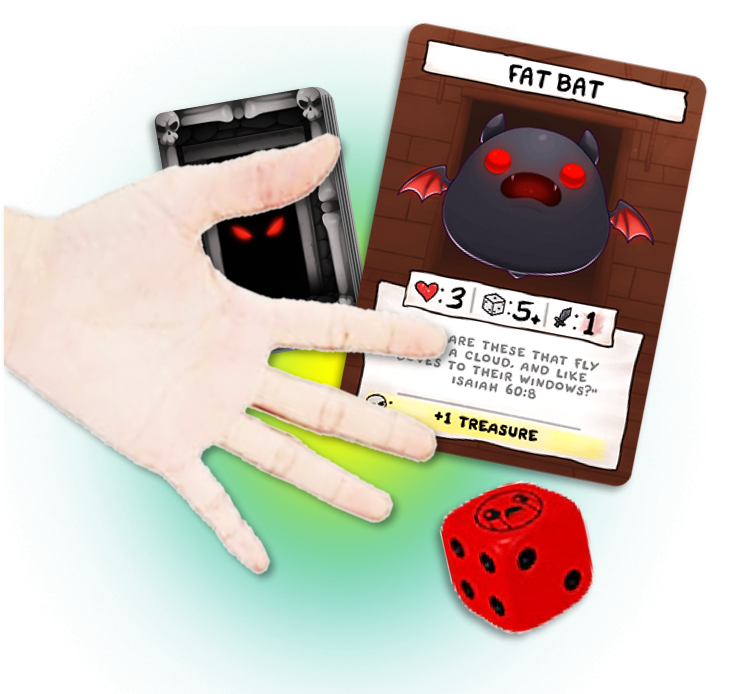
- Attack (up to once)
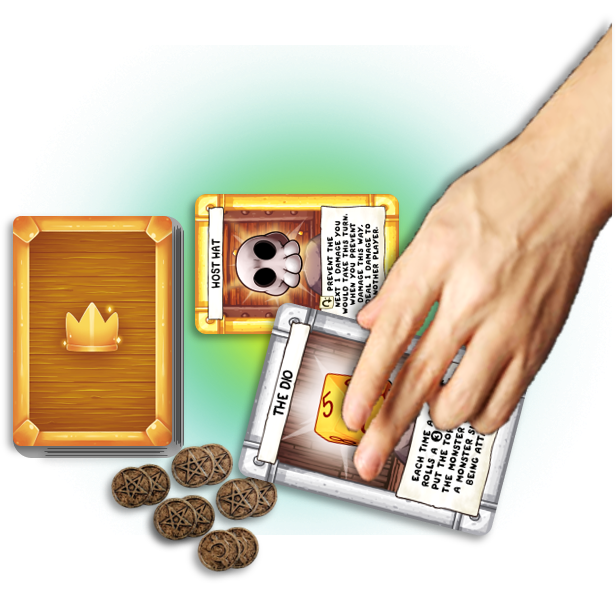
- Purchase (up to once)
Or END THE TURN (End Phase)
You may take as many action as you want as long as you have Loot play and Abilities that you can activate while you are at Priority. Dough the Active player have one attack and purchase by default, these my increase by some effects. When you’re done, you pass Priority to the next player so they have a chance to respond.
How does Priority Works?
What does it mean when priority passes to another player?
When priority passes, it means the player currently taking their turn, or the ‘active player,’ gets to play cards first. They can put down as many cards as they want, one after the other. Once they’re done and decide not to add more cards, the next player to their left gets a turn to play cards in response.
What happens if the player to the left decides to play cards in response?
If the player to the left plays any cards, the priority goes back to the active player. This gives the active player a chance to react to the new cards played by adding more cards of their own if they wish.
Can a person have two Priority Pass?
No. However, a player will regain priority each time it’s their turn or after another player responds to their actions, effectively getting multiple opportunities to act within the same round of play.
If all player passes Priority in succession (assuming no one wants to respond) the game continue, either by resolving the most recent loot, ability, roll, or by proceeding to Phase of Turn.
In an event that there’s no one has priority, player can’t play effects.
The Stock

How does The Stock works?
The Stack is like a pile where you put actions and effects that are waiting to happen. Players take turns adding to the Stack and can also react to what others put on it.
For example, if one player uses an item, another can respond with their own card before the first item’s effect happens. The last thing put on the Stack happens first. This rule is used for buying items, rolling dice, fighting, and other important parts of the game. It makes sure everyone gets a fair chance to react and plan their moves.

How to resolve The Stack?
Think of the stack as a deck of actions stacked one after the other. Once everyone finishes adding their actions, you begin resolving from the top action down. You carry out what the top card instructs, then proceed to the next, continuing this way until all actions have been carried out, till stack is empty.
Playing Effects
You have several options to influence the game’s direction. You can use loot cards, activated effects, or paid effects to make things happen, which is collectively known as ‘playing an effect. An effect is something that happens due to a loot or ability. When a loot or ability resolves, it may create more effects.
More...
Effects refers to the specific actions or consequences that are triggered when cards are played or certain conditions are met in the game. These effects can vary widely depending on the type of card or game situation and can include things like gaining resources, affecting other players, modifying gameplay rules, or engaging in combat with monsters. Example are as follows:

- An Item card might have an effect that allows a player to roll an additional die during combat.

- A Loot card could have an effect that lets a player steal resources from another player.

- A Monster card might have an effect that triggers when it is defeated, such as granting the victorious player additional loot or a soul.
Above are sample to give you a better ideas of what “Effects” means.
Responding To Game Actions
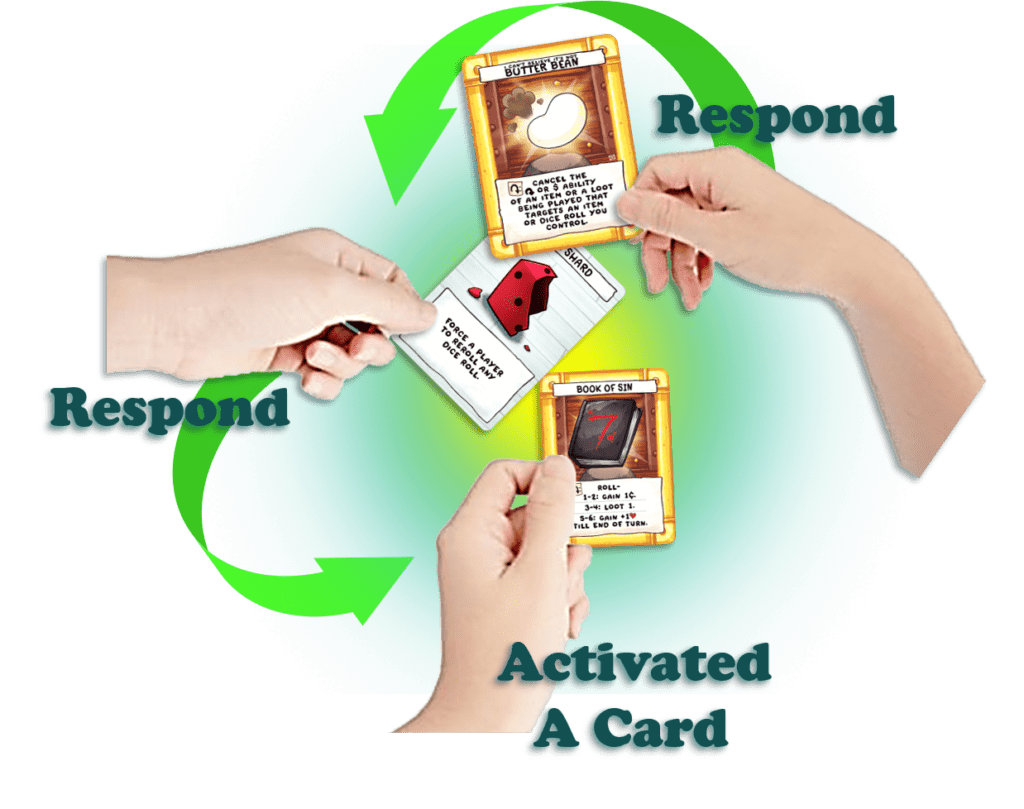
You can strategically respond to in-game actions like an action or effect from another player, you can react to it. You can do this by playing your own loot cards or using effects from your activated or paid items. When you respond, your action goes on top of the stack. This means your action will happen first, before the action you’re responding to. You also have the option to respond when the stack is empty, which is actually the only time you’re able to buy items or attack other players.
Bartering & Treats
Bartering is encourage in the game. The only rule is you can only trade coins for favors, not the items or cards you have. Both players must agree on the deal for it to go through.
In “The Binding of Isaac: Four Souls,” bartering and even making threats are part of the social strategy. You can barter by exchanging coins for favors, like asking someone to use a loot card in return for coins. Threats can also be part of the deal, like threatening to use a loot card against someone unless they pay you coins. You may or may not follow on your promise or still do your treats, as you wish. Just remember, it might cost you trust and make you a target for others in the game.
Dice Roll
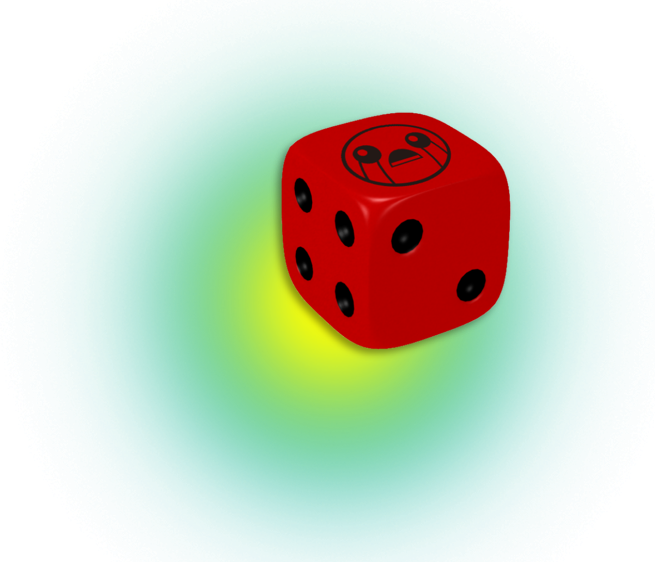
The dice is the arbiters of fate, used in combat and certain game effects, adding an element of chance that keeps every round unpredictable.
How to do a Dice Roll?
You roll the dice for the following:

- Dice rolls for Attacking Monsters.

- Dice rolls for some effects.
Rolling The Dice
Attacking Monster
Lets just say your character is “Isaac” and you declared an attack against the monster “Fat Bat” and you roll the dice:
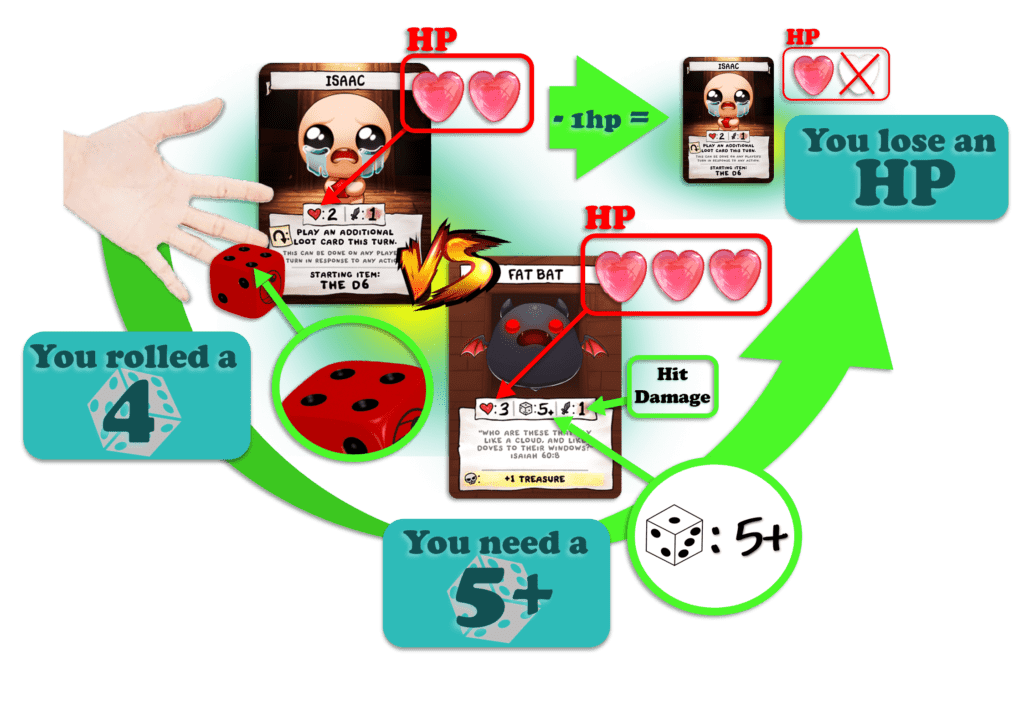
- The player, as Isaac, rolls a die and gets a 4 in combat against Fat Bat.
- Isaac needed to roll at least a 5 to successfully hit the monster.
- With the roll falling short, Isaac fails to hit and takes damage.
- This results in Isaac losing one heart point, indicating he’s been hit by the monster.
Let us consider another scenario, you’re character is still “Isaac” and you declared an attack on “Conjoined Fatty“.

- The player, as Isaac, rolls a 1 during combat against the monster, Conjoined Fatty.
- To hit the monster, the player needed to roll at least a 3.
- The roll being less than required, unfortunately, results in Isaac taking hit damage.
- Isaac loses 2 heart points due to the monsters(Conjoined Fatty) attack with 2 hit damage, which triggers the Death Penalty for the character dieng on attacking.
Active player continuously roll the dice until the monster or active player gets defeated, unless some effects have been activated.
Responding To A Dice Roll
Effects can modify the result of a dice roll, belows are such examples.

Starting Items
Your character being Isaac has The D6 starting item that comes with it.

The D6 (Starting Item): This card allows a reroll. After rolling the dice, if you don’t like the result, you can activate The D6 to try for a better outcome.
Cards At Hand
Assuming you have these 2 cards on your hand. (Or maybe some other cards with almost the same effects.)

- Dad’s Lost Coin: If you roll a 1, you can change it to a 6, improving a poor roll to the best possible outcome.
- Sacred Heart: This card lets you force a reroll if you roll a 1, giving you a second chance to get a better result.
Attacking For Effects
When rolling dice for various effects in the game, the outcome can trigger different rewards or consequences. Each card presents unique challenges and opportunities based on your roll, making each game unpredictable and exciting. Sach are the 2 sample below.
Wheel of Fortune Card (Loot)

You just simply roll a die for various outcomes:
- Roll a 1: You gain 1 coin.
- Roll a 2: You take 2 damage.
- Roll a 3: You loot 3 cards.
- Roll a 4: You lose 4 coins.
- Roll a 5: You gain 5 coins.
- Roll a 6: You gain 1 treasure.
Some card ask for condition or actions such as paying if you choose to engage, like the one below.
Beggar Card (Room)

If you choose to engage by paying 3 coins, you can roll a die for various outcomes:
- Roll a 3 or 4: You gain 2 coins back.
- Roll a 5: You loot 2 cards, which could give you more options.
- Roll a 6: You’re rewarded with 1 treasure card, but then the Beggar card is discarded.
It’s a gamble that can result in regaining coins, acquiring more resources, or even earning a valuable treasure, depending on the luck of your roll.
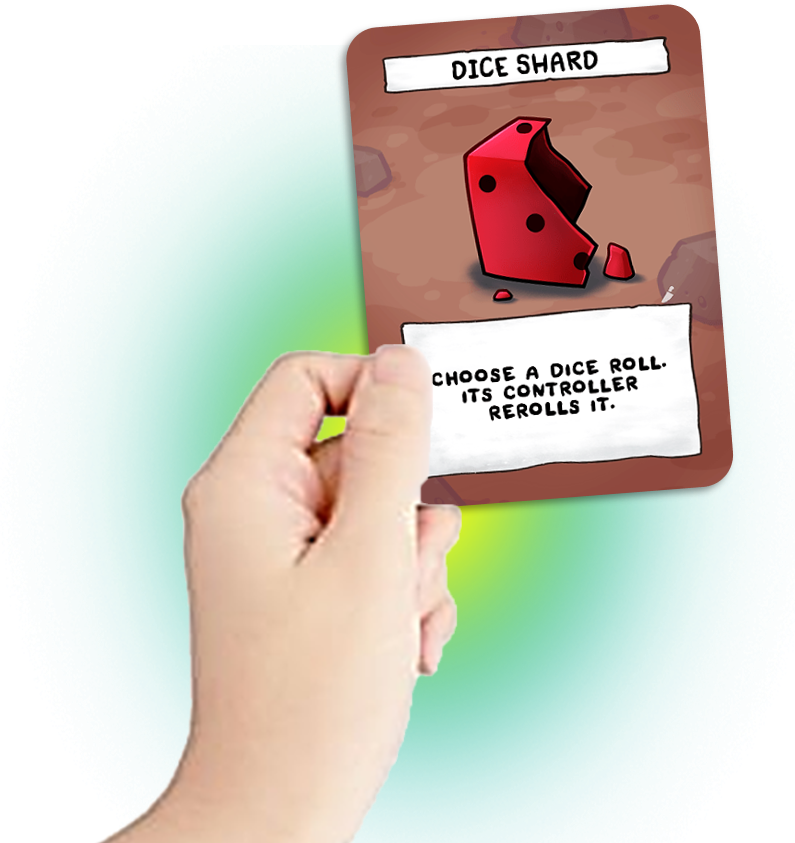
If you need to roll a die for a game effect, roll it first and then add that number to the ongoing list of actions(stack). Only initial rolls go on the stack, effects that reroll simply modify the result on the stack (See Stacking)
Death Penalty

If you died during an attack, the attack stops and you pay the Death Penalty.
“Death Penalty” are the punishment for being defeated or dieing from attacking monster.
What are the Death Penalties?
Here are the Death Penalties when you die from attacking:
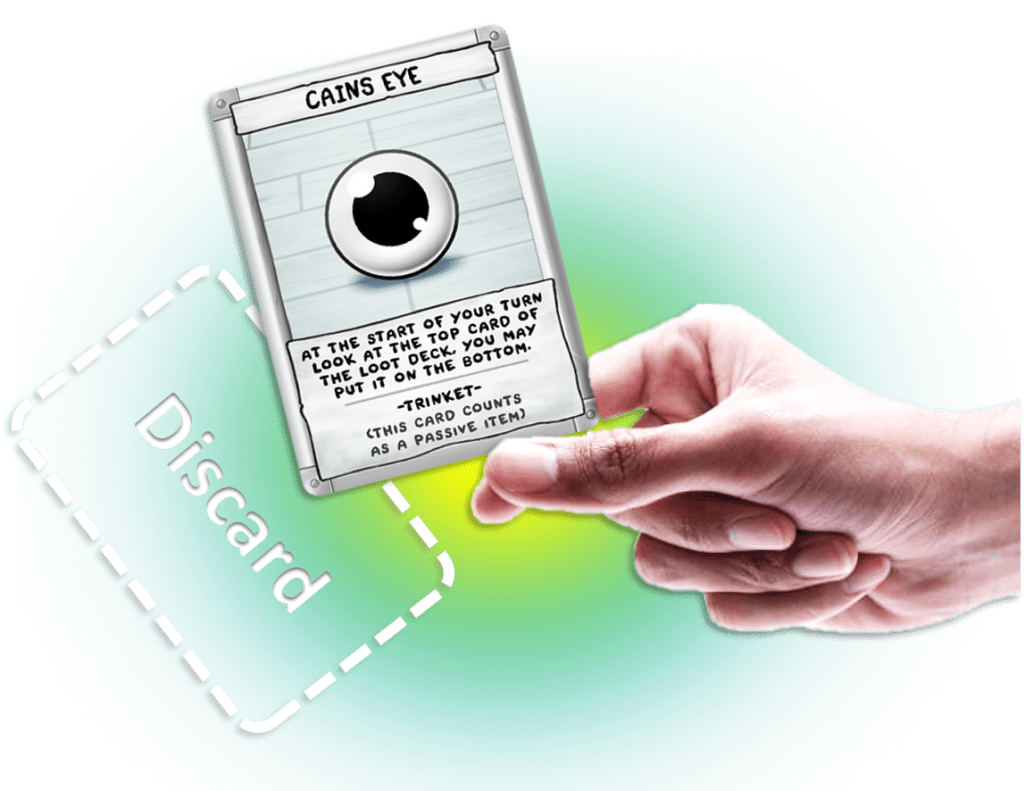
1. Choose and destroy a non-eternal item you control.
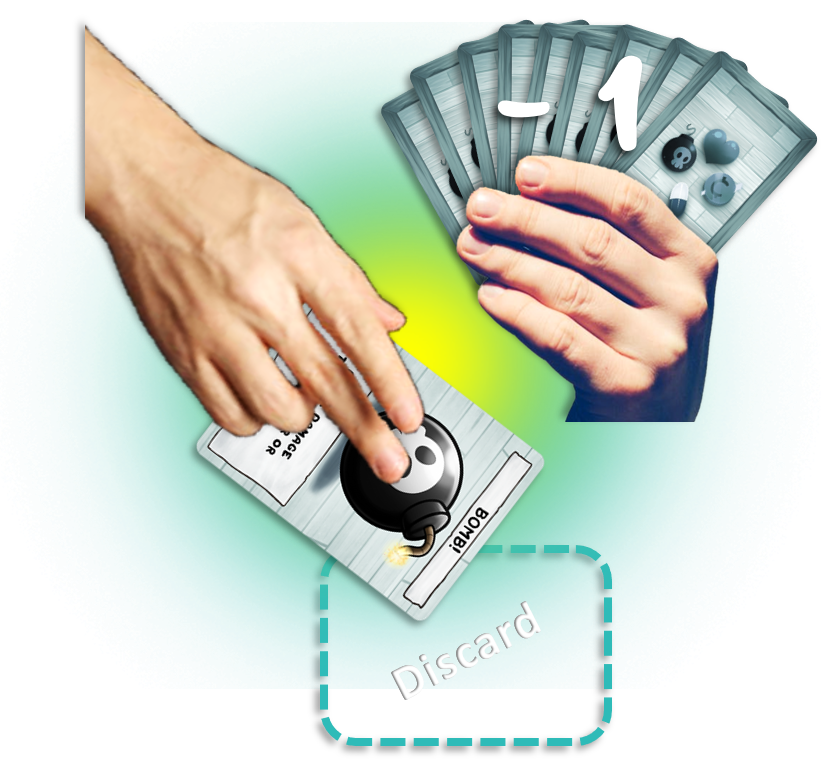
2. Discard 1 Loot Card.

3. Loose 1 cent.

4. Deactivate all your item as well as your character.
After paying the Death penalty, Active player jumps to End Phase.
Now, let us go through some common gameplay questions.
Common “The Binding of Isaac Four Souls” Questions
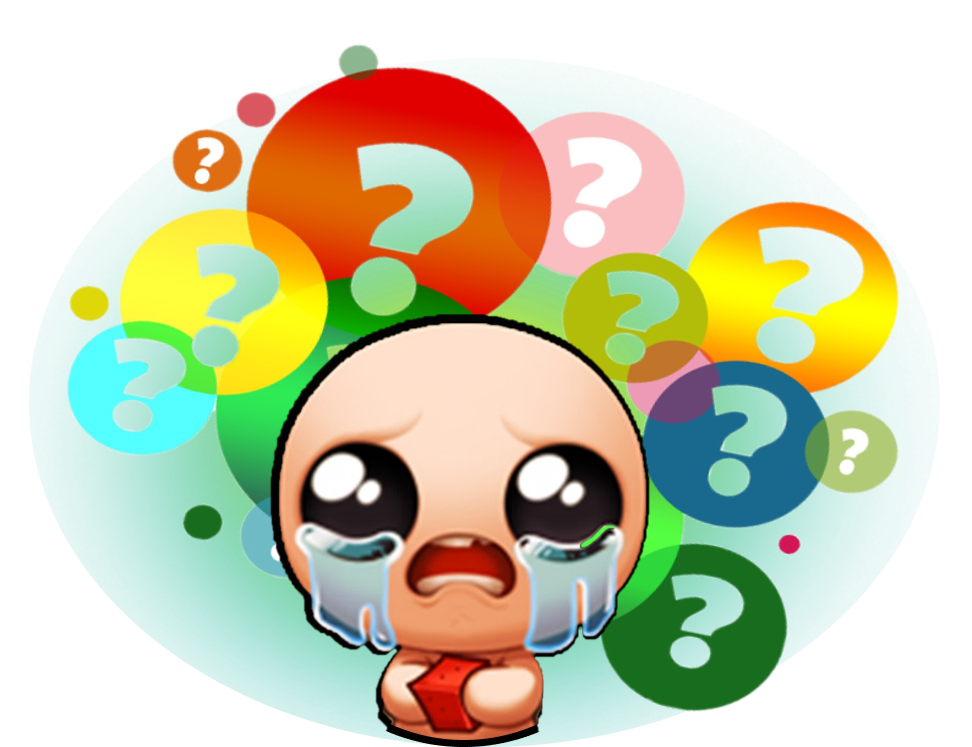
Q & A Table of Content
Click on the category of questions below, or simply scroll down.
Loot Cards Questions
Turning Trinkets into Items
- Q: Do I need to use a trinket card from my hand to make it an item?
- A: Yes, you need to play the trinket card from your hand. Once it’s played and its effect happens, it becomes an item and stays in play just like any other item until it’s removed or destroyed.
Understanding Game Items
Q: What counts as an item in the game?
A: Items include anything you can buy in the shop, find in the treasure deck, or have in play in front of you, marked by either a silver or gold border. It’s important to note that loot cards aren’t considered items. However, there are special loot cards called trinkets which turn into items and stay on the table when you play them, unlike regular loot cards that are used and then discarded.
Using Butter Bean on Trinkets and Lost Soul
- Q: Can I use Butter Bean to stop a trinket or the Lost Soul card from being played?
- A: Yes, you can use Butter Bean to stop any loot card, including trinkets and the Lost Soul card. Trinkets and the Lost Soul card are not considered items or souls until their effects are completed.
Order of Discarding with Butter Bean
- Q: What’s the discard order when Butter Bean cancels a loot card?
- A: The loot card that got cancelled goes into the discard pile first, and then Butter Bean goes on top of it in the discard pile.
Using Counterfeit Penny for Extra Coins
- Q: Does the Counterfeit Penny give an extra coin when I steal or trade?
- A: No, the Counterfeit Penny only gives you an extra coin when you get coins from a card that says ‘gain’ coins. It doesn’t work for stealing or trading coins.
Attacking and Monster Card Questions
Gaining Rewards from Defeating Monsters
Q: What happens if someone defeats a monster on another player’s turn?
A: Whoever’s turn it is (the active player) gets the rewards from any defeated monster. If the monster is a boss, they also get its soul.
Encountering Non-Attackable Monsters
Q: What if I reveal a monster from the deck that can’t be attacked?
A: If you draw a non-attackable monster like Stoney or Death’s Head, it goes to an active slot, but your attack doesn’t happen. This still counts as your attack for the turn, though.
Simultaneous Lethal Damage
Q: What if a player and a monster both would die at the same time?
A: Usually, the game’s rules decide who gets hit first. But if an effect hurts both at once, like Lust’s effect, the monster’s death is resolved first, then the player’s.
Dying from a Monster’s Effect
Q: If I’m low on health and my attack roll that would kill the monster also triggers its attack on me, who dies first?
A: The monster’s attack effect goes first. If it kills you, your attack on the monster doesn’t happen, so the monster survives.
Damaging Non-Attackable Monsters
Q: Can I still hurt non-attackable monsters with cards and items?
A: Yes, you can use items and cards to damage and possibly defeat monsters like Stoney and Death’s Head, even though you can’t attack them directly.
Forced Attacks with Full Monster Slots
Q: What happens if a card forces me to fight the top monster card but all slots are full?
A: If all slots are filled with monsters that can’t be covered, the effect to attack the top deck monster doesn’t happen, and you can choose to attack an active monster instead.
Monster Rewards with Rolls
Q: What’s it mean when a monster’s reward includes a dice roll for coins or loot?
A: When you defeat this monster, you roll a dice to figure out your reward. The number you roll is the amount of coins or loot cards you get. It’s like a little bonus game after you win the fight.
Killing Monsters to Avoid Damage
Q: Can I kill a monster with a card to avoid its attack killing me?
A: Yes, if you kill the monster during the attack, the attack ends, and any rolls against it are cancelled since the monster is no longer there.
Q: What Defines a Curse Card?
A: A curse card is a type of card that, when in play, negatively affects the player who has it. These cards are designed to challenge a player’s strategy and can be introduced into play through various game actions, often as a result of attacks from other players. The primary role of curse cards is to add an element of risk and uncertainty, potentially impacting a player’s ability to win if not addressed.
Mechanics of Ambush Cards
Q: What is an Ambush Cards?
A: An ambush card in the game triggers an expansion of the monster slots by two. Following this, the player whose turn it is must launch an extra attack against a monster occupying one of these newly added slots during their turn.
Character Card Questions
Eden’s Item Selection
Q: What happens to the items Eden doesn’t choose at the start?
A: The treasure cards Eden doesn’t pick are placed at the bottom of the treasure deck.
Using “Destroy This” Items as Eden
Q: Can Eden start with an item that says ‘Destroy this’?
A: Items that say “Destroy this” don’t really work as Eden’s starting item because they’re meant to be used once and then discarded. If Eden picks such an item, it won’t be destroyed due to becoming eternal, making it less useful.
Choosing Glass Cannon for Eden
Q: Is Glass Cannon a good starting item for Eden?
A: Glass Cannon is an exception to the rule about self-destructing items. It can be used as Eden’s starting item because its main effect doesn’t depend on the item being destroyed. However, you won’t get the ‘Loot 2’ effect if the roll is 1-5, since it can’t destroy itself.
The Forgotten’s Bone Transformation
Q: What happens when the Forgotten’s Bone becomes a soul?
A: Once the Forgotten’s Bone is turned into a soul, it can be stolen, discarded, or destroyed just like any other soul card. It loses its eternal status and any special protections.
The Lost’s Starting Soul
Q: Can the Lost’s starting soul be taken away or destroyed?
A: No, the Lost’s starting soul is safe and can’t be stolen, discarded, or destroyed. It’s a permanent part of the Lost’s character card.
Player’s Death Questions
Dying More Than Once
Q: Can you die more than once in the same turn?
A: You can only die once each turn and will be fully healed when the turn ends. But, it’s possible to die once on each player’s turn before it’s your turn again.
Dealing Damage to a Dead Player
Q: Is it possible to hurt a player who’s already ‘dead’?
A: You can’t choose to hurt a player who’s already dead. But, if there’s an effect that hits everyone or targets players next to someone, a dead player might ‘take’ damage from that. Remember, a player’s health can’t drop below 0.
Playing Loot Cards After Dying
Q: If I die, can I still use my loot card for that turn?
A: Yes, you can play your loot card in response to dying, as long as you haven’t played one yet. After you’ve dealt with the Death Penalty and the game has moved to the End Phase, you can’t play a loot card unless you have a special way to do so, like tapping your character card.
Preventing Player Death
Q: What if something stops me from dying?
A: If an effect stops you from dying, your health goes back to what it was before you were about to die.
Active Player Death and Game Flow
Q: What if the active player dies and there are open spots for monsters or in the shop?
A: If the active player dies and there are open spots, they have to fill those spots at the start of the End Phase. Any non-monster cards that come up get played like usual.
Souls Questions
Swapping Souls Between Players
Q: Can players trade soul cards with each other during the game?
A: Game rules keep soul cards as non-tradable to maintain the integrity of each player’s victory path. However, players can always choose to add house rules that allow for such exchanges, provided all players agree.
Discarding and Stealing Multi-Value Soul Cards
Q: What if I have to give up a soul card or someone takes one, and my only soul card counts for two souls?
A: Even if your soul card is worth two souls, you’d still have to give it up if asked because it’s considered one soul card. The same goes for someone trying to take a soul card from you; they can take your two-soul card just like any other.
Handling Bonus Souls That Are Lost
Q: What happens to bonus souls if they’re thrown away or taken out of the game?
A: If a bonus soul gets thrown away or taken out, it’s turned face down next to the game area and can’t be picked up again by anyone.
The Stack Questions
Simultaneous Passive Item Triggers
Q: What if two passive items I have activate at the same time?
A: Their effects go onto the stack based on the turn order, and then they work out in the reverse order. If you own both items, you get to choose the order they’re stacked.
Commitment to Actions
Q: Can I change my mind about attacking or buying from a deck if someone changes the top card after I decide?
A: Once you’ve chosen to attack or buy, you’re locked into that decision, even if the top card changes before your action happens.
Overlapping Effects on Rolls
Q: What if my item and a monster I’m fighting both do something when I roll a certain number?
A: The monster’s effect goes on the stack first, then your item’s. They’ll resolve starting with the last thing that was added to the stack.
Avoiding Death with Items or Loot Cards
Q: Can I use an item or card to stop my attack if a dice roll would kill me?
A: Yes, you can use an item or card to cancel the attack, putting its effect above the dice roll on the stack, so it resolves first and prevents the fatal outcome.
Prevent damage VS Activate when damage is taken
Q: If someone has a card that stops damage like Dead Cat, and also has a card like Fanny Pack that works when they get hurt, does Fanny Pack still work if they’re hit but don’t lose health because of Dead Cat?
A: No, if the damage is stopped by something (like Dead Cat, Guppy’s Hairball, Yum Heart, or a soul heart), then it’s not considered as getting hurt for cards like Fanny Pack that need you to take damage to work.
Choosing Effects on Cards
Q: If I use a card with multiple options and someone reacts, can I pick a different option later?
A: No, once you’ve picked an option and put it on the stack, you can’t change it, even if someone responds to your card.
Activating Items in Response
Q: Can I use an item if someone’s about to deactivate it?
A: Yes, if you activate your item in response, its effect will go above the deactivation on the stack and resolve first.
Playing Cards in Response to Discards
Q: If I’m forced to discard, can I use that card instead by activating my character card?
A: Yes, by activating your character card in response, you can play the card before the discard effect resolves.
Treasure Card Questions
Accumulating Treasure Cards
Q: Is there a limit to how many Treasure cards a player can have?
A: No. There isn’t a set limit to the number of Treasure cards you can have active at any given time, allowing for diverse strategies and combinations. This aspect of the game encourages players to seek out and accumulate powerful items to enhance their abilities and chances of winning.
Haunt Items Classification
Q: Are Haunt items considered curses?
A: No, Haunt items are just regular items, not curses. You can use any effect on them that works on items, like rerolling or swapping them, but you can’t use effects that specifically target curses.
Finding Haunt Items in the Shop
Q: What happens if a Haunt item shows up when we’re adding items to the shop?
A: Haunt items go into the shop just like any other item. If one comes up while filling a shop slot, it just takes that spot.
Daddy Haunt’s Damage Effect
Q: Does Daddy Haunt make a player take more damage or just add an extra hit?
A: Daddy Haunt increases the total damage you take by 1. It doesn’t count as a separate hit on its own.
Classification of Haunt Items
Q: Are Haunt items considered as items in the game?
A: Yes, Haunt items are indeed classified as items and not as curses. This means they can be affected by any game action that targets items, such as rerolling or specific effects from cards like Contract From Below or Donation Machine. However, they’re immune to effects that specifically target curses, so cards like The Bible or Dagaz won’t affect them.
Q: Can you play The Binding of Isaac Four Souls with 5 or 6 people?
A: “The Binding of Isaac: Four Souls” is officially designed for 2 to 4 players. However, it’s not uncommon for players to accommodate more participants by tweaking the rules or game mechanics. If you’re considering playing with 5 or 6 people, here are some suggestions to keep the game enjoyable:
- Increase the Game Length: With more players, the game will naturally take longer to play. Make sure all players are aware and okay with the extended duration.
- Adjust the Starting Resources: To balance the game, consider modifying the starting items, coins, or loot cards for each player.
- Modify Victory Conditions: You might need to adjust the number of souls required to win to keep the game competitive and balanced.
- Implement Turns Wisely: More players mean longer wait times between turns. Encourage quick decision-making to keep the game flowing smoothly.
- House Rules: You may need to introduce or modify rules to manage interactions and resolve conflicts with more players in the game. (Like: only the players on the left and right of the active player can respond with effects)
See Extended Rulebook if you have any further questions, or visit Four Souls website.
The Binding Of Isaac Four Souls Extended Rulebook

Wee’s Wrap-Up
Wee here, signing off with a little heart-to-heart about why “The Binding of Isaac: Four Souls” deserves a spot on your game shelf. Let’s be real – it’s not just a game; it’s like stepping into a story, filled with twists, turns, and a touch of dark humor that somehow brings everyone closer. Every card flip is a new plot twist, making each playthrough as unique as the folks you’re playing with. Whether you’re a master strategist or just in it for the laughs, this game has something special for you. And honestly, isn’t that what game nights are all about? Sharing stories, building memories, and maybe, just maybe, a little friendly backstabbing along the way. So, from one gamer to another, give “Four Souls” a go. Wee promises, it’s more than just a game – it’s an experience that’ll keep you coming back for more. Lastly, big thanks to Edmund McMillen and Maestro Media for creating an amazing game.

